It all made for interesting socializing. The overarching impression, however,
was the sensitivity to the customs, culture, and ways of the others. And
the incredible hospitality of the Saudis.
Everywhere, there are watchtowers where the men would keep lookout for raiding parties from rival tribes.
Today, the towers are crumbling from neglect, but the wells are still used to irrigate crops.


Several hours drive from Al Baha, in the mountains, is an old village built on an outcropping of white rock and
called by its nickname, the Marble Village. I had not heard of it, but when visiting in the city of Al Baha, I
struck up a friendship with a local Saudi. He asked if I had seen it, and when I said I had not, he
offered to take me there, and the next weekent, we went. It appeared deserted when I toured it, but there is a working
banana plantation just below it, well tended and irrigated from a spring that gushes forth out of the rock above and behind
the village. The outflow from this small spring was cleverly channeled down the hillside to and through
the banana palms. Whether or not it may have served as a water supply for the village itself, I do not know. But
it supported a lush growth of trees and other vegetation around the village.
This is one of the most mysterious, lovely, and remarkable places on the planet.
The Marble Village
Also known as Dhee Ayn, it is a 400 year old abandoned stone settlement
built atop a marble hill. It is 24 km south of Al Bahah along Al Aqabah Road.
The village is surrounded by Palm groves, banana, vegetable and herbal plantations,
a permanent stream and natural wilderness.
The "source" of the irrigation water
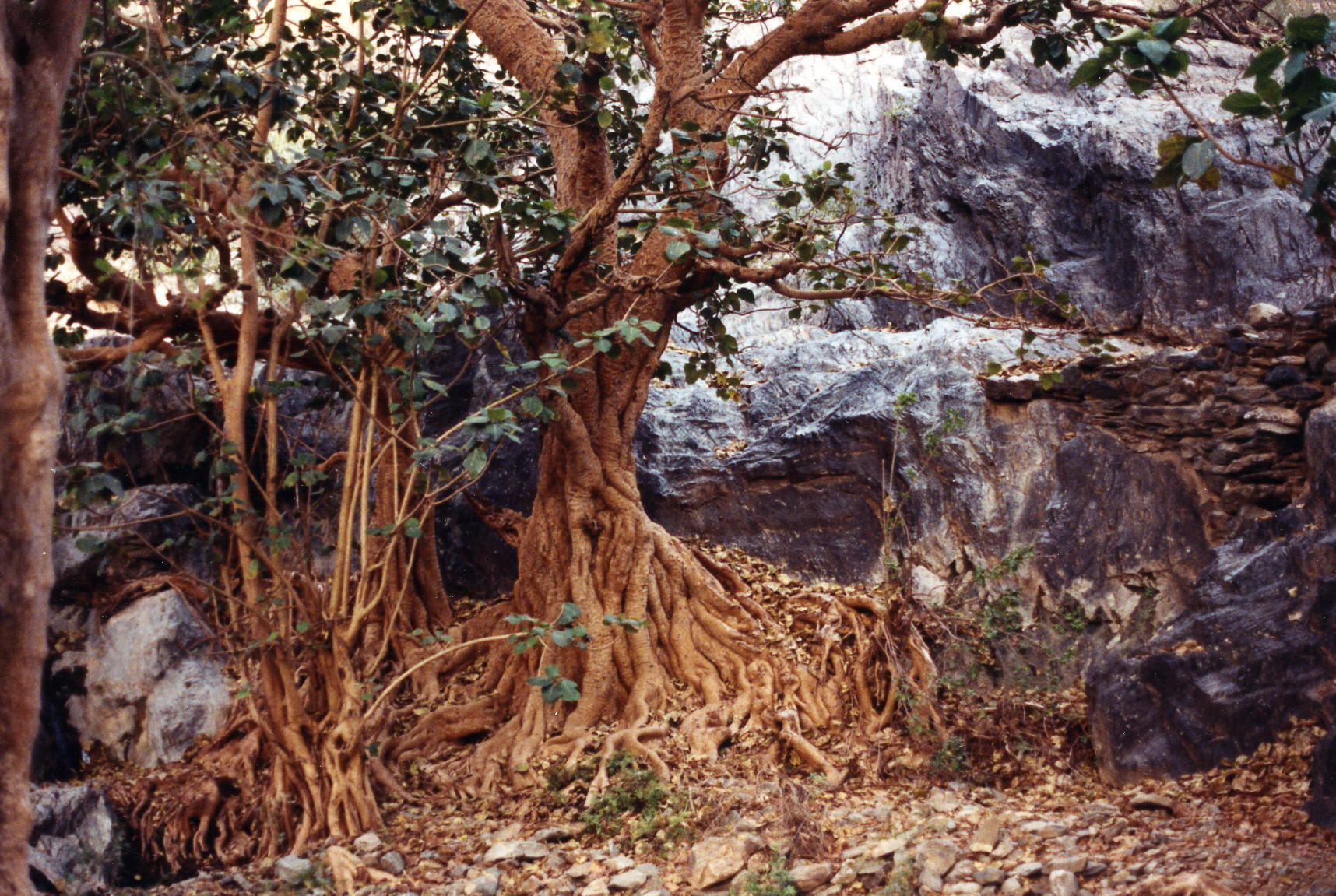
Some personal notes and thoughts about Yemen
The Asir of Saudi Arabia blended with the adjacent highlands of northern
Yemen. Many of the peoples, families, and clans in that area lived on
both sides of what is today the "official" border between the two nations.
But for centuries, that boundary was fluid at best if not downright
theoretical, as tribal loyalties determined geographic control of the
lands.
As mentioned above, in the history of the Saudi Red Crescent Authority, that
organization began in the 1930s in part to care for soldiers wounded in the
war then on-going between Saudi Arabia and Yemen. There have been many
wars between the two parties in the decades since despite a
"peace treaty" defining a formal border in 2000.
Yemen has a long and complicated history of internal conflicts often
exacerbated by "assistance" to one or more of the warring parties by
outsiders, not unlike the present day War in Yemen.
This complex history can be partially understood by series of
"half-truth" about the country.
The northern part of Yemen is
mountainous and populated by tribes with fierce loyalties and
long history of inter-tribal warfare. Through
most of recent (20th century and beyond) history, the capital of
this northern part of Yemen has been Sana'a, an ancient city at the
foothills of the mountains. It was where the first "king" of
modern Yemen, Imam Yahya, lived and ruled from, who was
recognized as king by Italy in 1904. His reign was marked
by isolationism, supression of dissent, and neglect of
development of infrastructure and education. This king was
succeeded upon his death in 1948 by his son, Imam Ahmad. Ahmad
relocated the capital to Ta'izz and began a program of
economic and social development. But, upon his death in
1962, there was a coup led by the military with the death
or exile of many of the royal family and the capital
was returned to Sana'a. Rural hill tribes opposed the new
government, and with the support of Saudi Arabia (and Britan
and Jordan) launched
the North Yemen Civil War, opposed by the "republicans",
backed by Egypt and the United Arab Republic. The civil
war ended in 1968 with the victory of the republicans and the
declaration of the Yemen Arab Republic, a socialist entity, but
conflict among various parties continued for years afterward.
In the meantime, there was a British "Protectorate" in the
southern part of the country. The British had seized the
port of Aden in the mid 1800s to serve as a coaling station
for the British East Indian Company ships sailing to and from
the "far east". The British had also made alliances with multiple
adjacent tribal entities, to provide a buffer
zone of thousands of acres protecting the port
and creating the Aden Protectorate. By the late 1950s and early
1960s, the rising tide of Arab Nationalism threatened
the stability of the Protectorate. That, plus the loss of
former British colonies (India) made the usefulness of
the port of Aden marginal at best, and the British withdrew
from Aden in 1967 without arranging follow up governance.
After the British withdrawal, the Yemeni National Liberation
Force took over and proclaimed the Republic of South Yemen, later
the Peoples Democratic Republic of Yemen, a socialist nation.
Relations between the two Yemens varied from quietly hostile to
open warfare, with each side receiving support from outside sources.
In the late 1970s, the Arab League brokered a peace treaty that
included committment to unification of the two states. But civil
wars among various partied continued in both the north and south
and between the two.
In 1990, the two governments agreed on a plan for joint
governing of Yemen, and the countries merged in May 1990.
The leader of north Yemen became President and that of
South Yemen, Vice President. There was a unified
parliament formed and elections held in 1993.
But after the Iraqi invasion of Kuwait in 1990,
Yemen's president opposed military intervention by any
non-Arab nation, and Yemen, a member of the United
Nations Security Council at the time, voted against the
use of force resolution before that body.
But as mentioned elsewhere, the U. S. and Saudi Arabia
had an agreement by which the U.S. would defend the Kingdom
if it were attacked. At the point where Iraqi forces
seemed poised to move into Saudi Arabia, the U.S. intervened
in the coflict.
Yemen's opposition in the U.N. Security Council to
several resolutions amounted to support for Iraq in
Saudi eyes, and the Kingdom abruptly expelled the
nearly one million Yemeni living and working in Saudi
Arabia as punishment for the Yemeni government position.
Before that time, Yemeni had been free to move easily
to and from Saudi Arabia and they constituted a large and
valuable part of the expatriot workforce in the Kingdom. They
were suddenly (and remain) persona non grata and were forced
out.
Political instability increased in both Yemens, and
in 1994 a civil war between the North and South broke out
with Saudi Arabia supporting the South Yemen forces. The
South lost the civil war and most of its leadership fled
the country.
By 1999 there was a unified government again under
the elected president Ali Abdullah Saleh, the former
president of North Yemen, who governed from Sana'a.
But political unrest continued and by 2000 there were
multiple terrorist attacks, generally by al-Quada
affiliated groups, Sunni Muslim fundamentalists.
In 2004, a Shia group termed the "Houthi" for their
leader Hussein Badreddin Al-Houthi began an uprising
against the Yemeni government alledging discrimination
and government aggression against the Shia.
The Shia insurgency in Yemen began in June 2004 when
dissident cleric Hussein Badreddin al-Houthi, head of the
Zaidi Shia sect, launched an uprising against the Yemeni
government. The Yemeni government alleged that the Houthis
were seeking to overthrow it and to implement Shi'a religious
law. The rebels counter that they are "defending their community
against discrimination" and government aggression. Ultimately,
the Houthi drove the government out of Sana'a to Aden
The Yemini military has been conducting a war against the Houthi
forces since that time. Al Queda remains active in Yemen also and
generally opposes the Houthi rebellion but concentrates largely
on U.S. targets. Saudi Arabia joined the conflict in 2014, supporting
the Yemeni government agains the Houthi.
The Yemen war thus evolved into a proxy war between the Sunni
Muslim nation of Saudi Arabia and the Shia Muslim nation of Iran, which
supports the Houthi.
And the Yemeni pay the price.
'
Brief History of the House of Saud
The al-Saud family was originally from
Ad-Diriyyah, a small town to the north of Riyadh, but they fled that town around 1890 when a rival
tribe, the Al Rashidi allied with the Ottoman Turks, raided and destroyed Dariyah and captured
Riyadh.
The Saud family fled to Kuwait where they lived in exile for nearly 20 years.
Abdul Assiz al Rahman Al Saud, (later known as "Ibn Saud") the son of the deposed emir,
returned in 1901 and worked to unite tribes of the desert region to the east and south of Riyadh,
the "Nejd", building alliances and eventually
recapturing the city of Riyadh in a daring nightime raid on January 15, 1902.
After the return of the Saud family, they remained in Riyadh and did not rebuild
their former home. Diriyyah was preserved a ruins and was available to tour as
a reminder of that part of the history of the House of Saud and the treachery of
the Al-Rashidi in allying with the Turks.
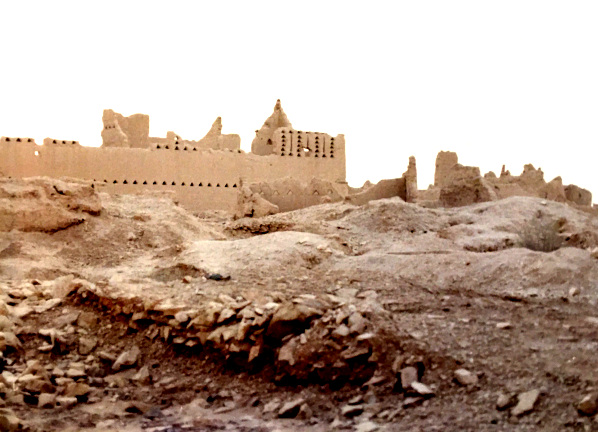
After the capture of Riyadh, many additional tribes joined Ibn Saud and over the next several years,
his forces recaptured most of the Nejd from the Rashidis, who then appealed to the Ottoman Empire
for military aid. The Ottomans sent troops into Arabia to assist the Rashidi, but Ibn Saud waged
a successful
guerilla war against the Turks and they withdrew. By 1912, Ibn Saud controlled the land all the way
from Riyadh to
the eastern coast of the peninsula, on the "Arabian Gulf".
Throughout this time, Ibn Saud worked closely with the strict, ultraconservative, Islamic religious order,
the Wahhabi, founded in the 1700s by followers of Mohammed Wahhab of the Nejd. Mohammed Wahhab had earlier formed
an alliance with Mohammed ibn Muqrin Al Saud, the emir of Ad-Diriyyah deposed by the Al Rashidi and father of
Ibin Saud. Diriyyah was an agricultural community and the ancestral home
of the Al Saud tribe.
After the conquest of the Nejd, Ibn Saud founded the Ikhwan, a military-religious brotherhood
which assisted in his conquests combining the zeal of conservative Wahhabi Islam with his
military needs of the day. This union and continuing close relationship of the Saud family and
the conservative fundamentalist Wahhabi was critical to the expansionn and creation of what
became the Kingdom of Saudi Arabia and has implications and repercussions stil.
During World War I, the British government established diplomatic relations with the newly
formed "House of Saud" and its new King, Ibn Saud. The British provided financial and military
support to the new "nation" as Ibn Saud contined his war against the Al Rashidi, allies of the
Ottoman Empire.
As an aside, the activities of "Lawrence of Arabia" and his guerilla warfare to distupt
Ottoman Turkish supply lines took place in the western part of the peninsula, also known as
the Hijaz, where Mecca, Medina, and Jeddah are located. These raids were often directed at the
"Hijaz railroad" connecting the port of Aquaba at the top of the Red Sea with Jeddah a port
along the eastern coast of the Red Sea and a major shipping point and access to the
Muslim holy cities of Mecca and Medina. During this time, the lands
west of Riyadh and the Hijaz were not under control of the House of Saud.
After World War I, Ibn Saud continued his war against the Rashidi, the latter now without
the aid of the Ottomans, defeating them at the Battle of Hai'il in 1922. In 1925, Ibn Saud
completed his conquest of the western provinces by capturing Mecca.
and on 23 September 1932, united his
dominions into the "Kingdom of Saudi Arabia", with himself as its king.
As another aside, the Holy City of Mecca had been under the control of the Hashemite clan ("Hashimi"),
direct descendents of the Prophet Mohammed, for seven centuries.
In 1908, the Hashemite Hussein bin Ali was appointed Sharif of Mecca, an honorific term denoting a ruler who
is a direct descendent of the Prophet. The Hijaz was then under control of the Ottoman Turks, and
Hussein gradually developed ambitions for
an independent Arab Kingdom in the peninsula. During World War I, this interest in Arab nationalism
among Hussein and his sons, Abdullah, Faisal, and Zeid, led to their involvement in the "Arab Revolt"
against the Ottomans in 1916, an uprising that had been discussed and negociated with the British
since at least 1914.
Hussein had big ambitions and wanted to have the entire Arab peninsula,
Greater Syria, and Iraq under his family's rule. He looked for British support for this idea,
but found no support for his grand plan although the British probably did promise to
support a smaller kingdon in the western provinces. The Arab revolt,
an Anglo-Hashemite venture, finally broke out in June 1916. Britain financed the revolt and
supplied arms, provisions, direct artillery support, and experts in desert warfare including the
famous T. E. Lawrence. The Hashemites promised more than they were able to deliver,
and their ambitious plan ultimately collapsed for lack of support among other Arab
nationalists, especially in the areas later Syria and Iraq. But the guerilla war against
the Turks was effective in tying down Ottoman resources, and Hussein's son Faisal was a commander of Arab
forces working in collaboration with Lawrence and the British.
After the war, the British devised a "Sharifian Solution" to partially fufill some of the
conflicting committments they had made to various Arab groups.
This "solution" proposed that Hussein's son Ali would succees him as Sharif of Mecca and
two other sons of Hussein would be
installed as kings of two newly created countries across the Middle East: Iraq and Transjordan.
Abdullah, became the Emir of Transjordan in 1921 and King of Jordan in 1946. His descendants
continue to rule the kingdom known ever since as the "Hashemite Kingdom of Jordan". Abdullah was
assassinated in 1951, but his descendants continue to rule Jordan today.
Faisal, briefly proclaimed King of the Arab Kingdom of Syria in 1920, until he was removed by
France, who wished to remain in charge of Syria. Faisal then became King of Iraq in 1921. In Iraq,
the Hashemites ruled for almost four decades, until
Faisal's grandson Faisal II was executed along with the crown prince and other members of the
family in the 1958 British-backed military coup d'état. This was the definitive end of the
Hashemite dynasty in Iraq.
In case you were wondering where the messiness of the "Middle East" came from: blame the Brits.
And the French. They drew up the national boundaries without regard for tribal, ethinic, or
religious loyalties and continued to keep things stirred up to benefit their national and
imperial interests. The U.S. has simply continued this long sad story.
We went to or through England a few times, both to and from Riyadh or on
the way to other places. Here are a few pictures from London area and Brighton
just to show we were there and did all the tourist things. We even saw some
theatre there, on memorable time was taking the kids to see "Starlight
Express", the entire cast on roller skates zooming around the entire
theatre as they enacted the story of Rusty, the obsolete steam engine, who
dreams of glory by winning a great train race against the diesel champion.
The show was by Richard Stilgoe with music by Andrew Lloyd Webber. On a
later trip, I got to see the original London production of "Phantom of the Opera",
another Stilgoe-Webber pairing.






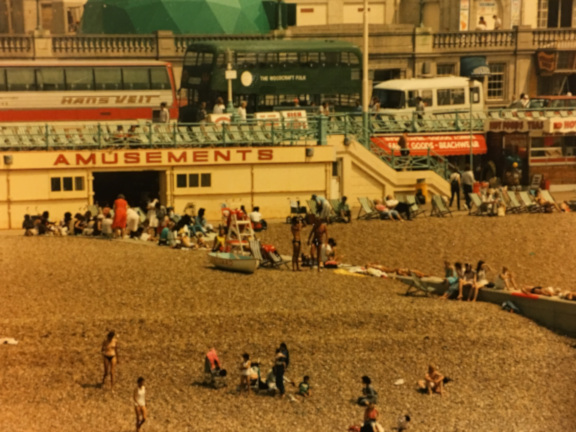
One very nice, relaxing trip was to the Canary Islands. We traveled first to Spain,
spending a little time there, before traveling on Iberia, the national Spanish
airline, to the Islands. Flying on Iberia was very nice and the food was great.
Once on Gran Canaria, we spent most of our time on the beach.
Many years later, after we moved back to New Orleans, we found out about
the "Islanos", an ethnic group of people descended from Canary Islanders, who
were brought to the Spanish Lousisiana territory in the late 1700s. There were
perhaps over 1,000 individuals settled in the lands downriver from New Orleans,
in part as protection from a possible British invasion of the lower Mississippi
River area. Over time the original settlers intermarried with local populations
and eventually lost their Spanish language and culture. Perhaps the most
prominent Islano was Leander Perez, the infamous "judge" who ran Plaquemines Parish
from the 1930s thorough the 1960s, known mostly for his extreme racist views and
the ruthless fashion in which he enforced segregation in Plaquemines and St. Bernard
Parishes. When we lived in New Orleans in the 1960s, Gene worked at the
Public Health Service Hospital, the "Marine Hospital", in New Orleans. The
active duty military personnel who worked there or were patients there could
not even buy gas at service stations in Plaquemines Parish because the U.S. Army
had been integrated in the 1950s. A strange thread of connection among
parts of a life.
The time on the Canary Island beaches was a great change from living
in Riyadh. Most of the tourists on the beaches at that time were from Europe,
mostly Spain and Germany, as the Canaries were a favorite, low cost, vacation
place, easy to get to on Iberia Airlines. The topless sun bathing women were
a notable change from living in Riyadh, also.
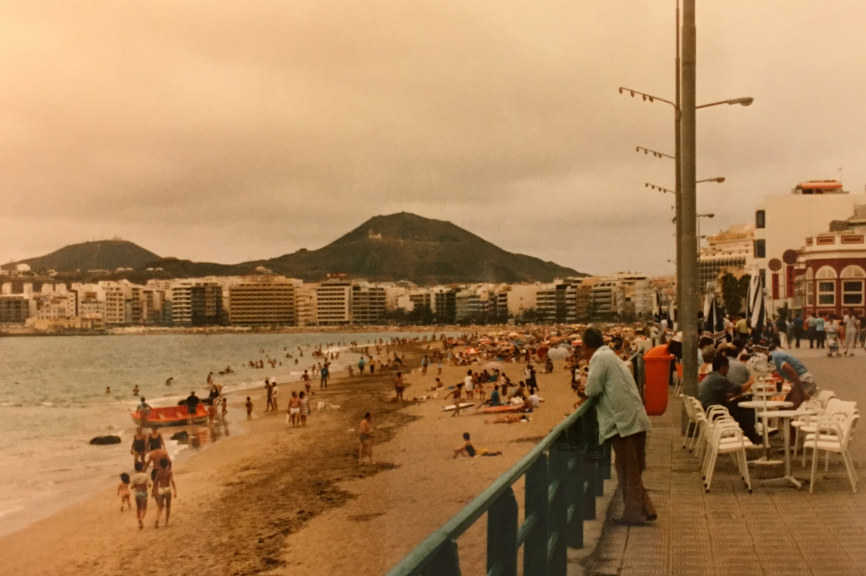
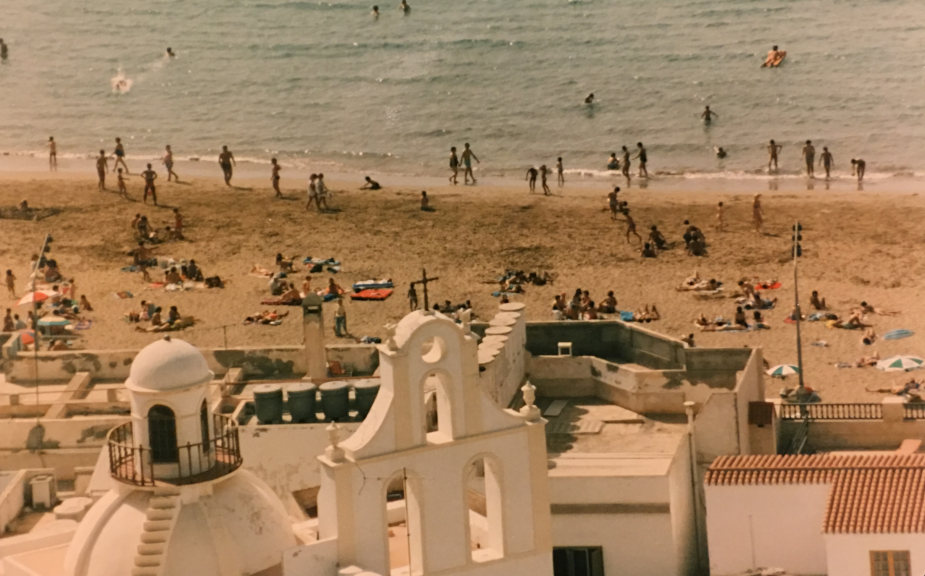
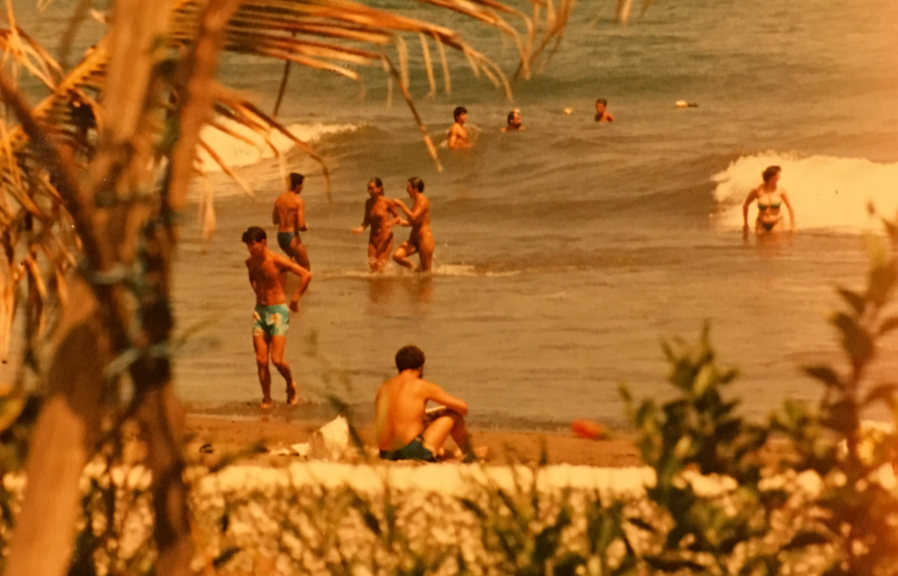
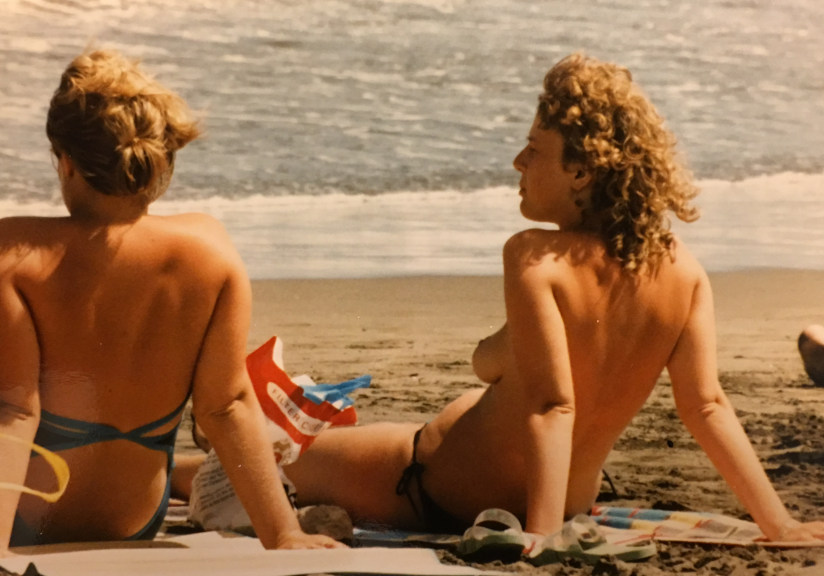
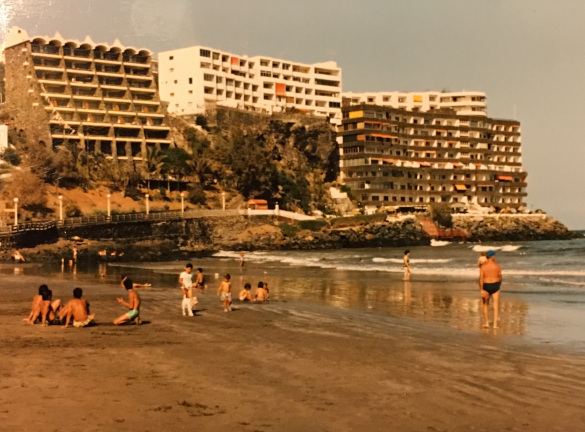
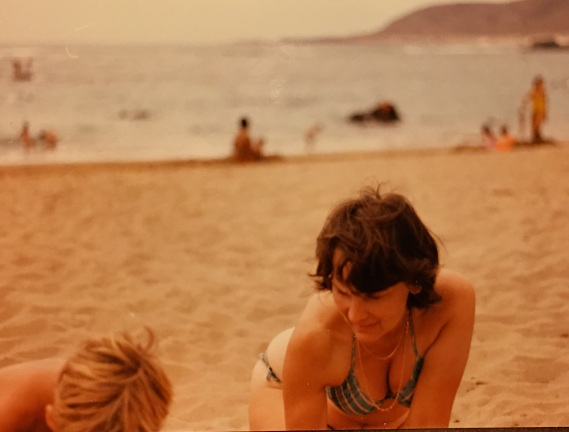
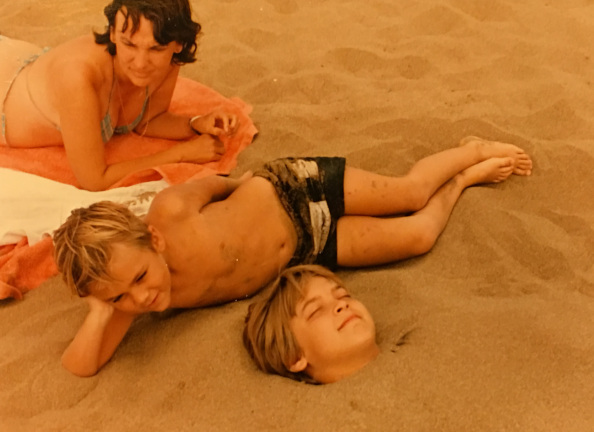
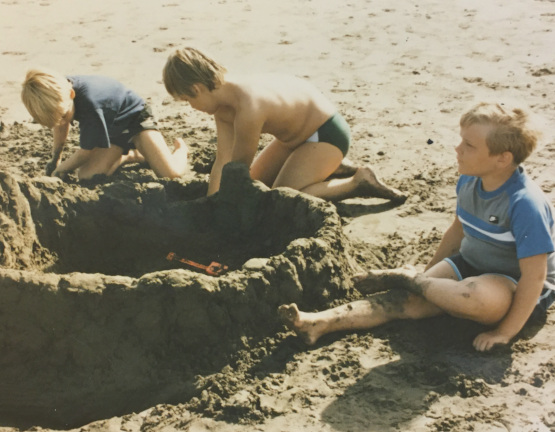


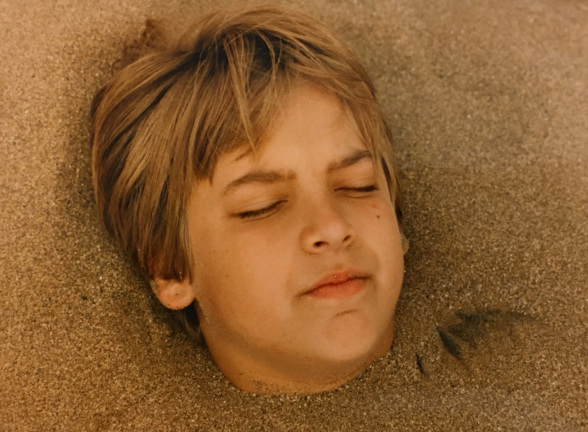

On one of our vacations, we traveled to Kenya and went on a ten day safari. The
trip had been arranged through a local travel agent in Riyadh, who had booked our
excursion with one of the many Kenyan "safari companies" based in Nairobi.
We traveled by air to Nairobi, arriving late at night, and were met by a representative
of the safari company and taken to a lovely hotel for that night. The next day
we met our driver, Barak, and our travel companions. The trips were in a
Nissan mini-bus with a maximum capacity of eight people. We were five, and
were joined by a very nice young British couple who were living and working in
the Eastern Province of Saudi Arabia. They were, fortunately, also very kind and
patient about traveling with three young children.
The next day, we traveled north to Samburu Lodge, where we stayed a day or two.
The Lodge had a night-time observation station by a waterhole there, and adjacent
land in a game reserve was teeming with animals. Barak threaded us through herds
of elephants and giraffes and sought out other animals for the photographers
in our party. The lodge was also a fine place to stay and relax after the
rather long drive up from Nairobi.
Then we headed south, stopping at the Mount Kenya Safari Club. The "Club" was
a grand hotel, now a Fairmont Hotel, which started its days as a hunting
lodge in the early 1900s. Sometime in the 1950s, William Holden, the American
actor and some friends bought a large parcel of land including the lodge and
founded the Safari Club. Sometimes called "Hollywood in the Wilds", it
became a luxury resort providing game hunting safaris to the wealthy. It was
a lovely, if over the top, place, and the dinner buffets were beyond compare.
Entertainment there included bird-watching, game-watching, and people-watching.
There was even a troupe of local native dancers-drummers on the huge lawn
in the afternoon.
From there, we headed south west to the Masai Mara, staying at Cottar's Camp.
It's the oldest lodge in Kenya's Masai Mara wildlife reserve, with tented bedrooms,
a luxurious main lodge, and a bar and lounge in a covered pavillion without walls,
overlooking the open bush. In the afternoons and evenings, there was a large
fire in a fire pit near the bar above the rows of tents where we sat and watched
huge herds of animals on the plain.
There are animals everywhere, and they freely wander through the camp and among the
tents, especially at night. The staff at the Camp is largely local Masai and
they serve as guides for walking safaris as well as security, especially during
the night. The white guides carry huge caliber rifles or shotguns. The Masai
men carry only their six foot long wooden spear.
The Cottar family was perhaps the only white
family given permission to establish a safari camp within the huge Masai Mara
game preserve, due largely to the patriarch of the family, a prominent American "white
hunter", who was known for his good relationships with the Masai anf for befriending
local tribal communities. His son
founded the camp in the 1920s and was later fatally gored by a rhinocerous. As
he lay on the ground bleeding to death from his mortal wound, his companions
rigged a sun shade for him to make him more comfortable, but he asked them to remove
it, as he wished to die looking at the African sky. If you stay at Cottar's Camp,
you will understand this.
Overall, the experience was a strange mix of left over elements of the days of
Colonial rule in Kenya in the main lodge and the bar, coupled with the
feeling that here, the animals are in charge, and it is only the Masai who
are truly adapted to and comfortable with, that world.
After a few days at Cottar's Camp, Barak asked us if we would be interested
in visiting a Masai village. We, of course, were happy to do so. At the time,
we hardly recognized what a splendid and unusual opportunity this was.
Evidently Barak had found us suitable to arrange such a visit. He had
sought out a nearby Masai women's village and made (or renewed) the acquaintance
of one of the women there. Barak spoke several languages: the language of his
own tribe and village, Swahili, the cobbled together trading language combining
Arabic, several local languages, and a bit of English, and, of course, English.
Our hostess at the village spoke Masai and enough Swahili to communicate with
Barak.
We drove to the village and spent a few hours there. This was a "Woman's Village",
and only women and young children lived there. More on this later.
The houses were made of
saplings plastered with dried cow dung. Since the area is dry most of the year,
except for a brief rainy season, the homes were weather tight. The women
built and maintained the homes. Each had a small cooking stove which also
provided heat. There were perhaps twenty women living there along with many
children. The houses were surrounded by a fence of rolled up and twisted thorn
bushes, with a gate opening at two locations. The fence also kept the
goats, the only livestock there, corraled and safe from predators. At night,
Masai men, who lived in their own village nearby, came to the women's village
and secured it for the night by rolling additional thorn bush barriers into
the gate openings.
The women and children were as curious about us as we about them. Our middle
son, Rob, was heavier than our other two sons, and the Masi were quite interested
in him and kept touching him, as they had never seen a child before who was not
as skinny as they. Barak explained their interest in Rob to us later. Rob, however,
later told us he had thought they wanted to eat him.
The Masai separation of the sexes was interesting to us, paralleling in a way,
the Saudi traditional customs, but more extremely so. What we learned follows.
The Masai believe they are God's chosen people. The evidence for this is that
God has given them cattle. Cattle are therefore sacred, and the duty of the Masai
is to raise the cattle, see they are fed, and protect them. Although Masai do
drink the blood of their cattle for nourishment, they rarely slaughter one
except for special occasions. The adult men are responsible for tending the
cattle, acting as herdsmen, and moving with the cattle to various locations
as the animals graze the plain. The men do not farm the land, for to do so
would break up the soil and kill the grass, which is what the cattle eat. Adult
males are also members of a society into which they are initiated at puberty.
Formerly, one final rite of passage was for the young male (a "junior warrior")
to go into the bush armed only with the short spear and to kill a lion. Although
when we were in Kenya, this practice was said to be abandoned, the Masai men
all still carried such a spear. They were clothed in a red cloak and we often
saw them against the sky in the cloak, with the spear across their shoulders.
Once, when we were driving in the area, we saw several lions who were hunting.
A short distance away, we saw two Masai men along the roadway and Barak stopped
to tell them there were hunting lions nearby. After several minutes of conversation,
we were again on our way down the road. When asked about what the Masai had
said when informed there were lions about, Barak quoted them as saying "We do
not fear lions."
Masai women lived in separate villages as described above. These villages were
relatively permanent in location and the women did some food gathering in the area
and some gardening, within the village confines. The women bore their children
in the village, and, after that, the woman remained in the village with the child,
nursing, for at least two or more years, not seeing her husband during that time.
Aferward, the woman would begin to see her husband again, spending time with him
at the men's village until pregnant again, when she returned to the women's village.
Children were raised in the women's village until near the age of puberty. At that time,
the boys became "junior warriors" and would leave the village to spend time with the
adult men, the "warriors". The girls remained in the women's village until they
developed menstruation, at which time they were initiated as adult women and married
a junior warrior.
Both boys and girls passed through several stages of maturing into adults, the boys
with the adult men, and the girls with the women. These stages included learning about
the duties of an adult and also multiple rituals and trials, including circumcision for both
males and females. Individuals passed through each stage of maturation with a peer
group of other of the same gender and approximately the same age.
At the time the boys left the women's village to live as junior warriors and begin
the path to adulthood, the girls of similar age became sexually active. The young
girls and young warriors would meet together outside the women's village and
during this period, usually would select a life partner for later marriage. But once the
girls experienced menarche and pregnancy was possible, their initiation into adulthood was
completed and they were married to the partner of their choice. The new couple would then
live together in the man's world until the wife became pregnant. At that time, she would
return to live in the women's village and the cycle would repeat.
In a land with scarce resources incapable of supporting large human populations, the
Masai way of life seemed to combine prudent population management with careful management
of resources needed to sustain life.
Some picures at the Mount Kenya Safari Club - the fireplace in the main lodge during the
cocktail hour, and the dancers drumming on the lawn below the lodge.

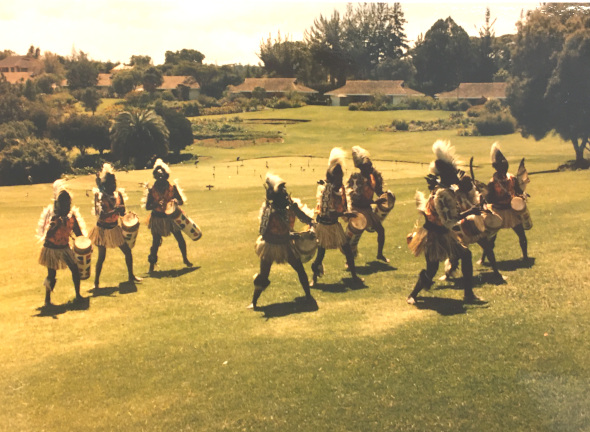
Samburu lodge and the game preserve adjacent. Many of the pictures of the
animals were taken with a 200 mm lens, so we were not a close at it would appear.
At least not dangerously close. The only animal Barak feared was the rhinocerous,
an animal Barak regarded as ill-tempered, stupid, and unpredictable.
The first pictures are from Samburu. Then there are pictures taken on
our travels down to the Masai Mara, then pictures from the Mara and finally,
pictures from our visit to the Masai village.
Barak was a wonderful guide with great knowledge of the animals and the country.
At one point, we came across two young male lions who were being persued by
two or more young male buffaloes. Barak explained that the buffalo and the
lions were enemies and that the buffalo protected their young from lions by
herding together with the young in the center. The herds consisted of females and
the young and a dominant male. Young males, who might be a threat to the dominant
male were excluded from the herd and lived on the outskirts of it. These young
male buffalos also protected the herd from lions. In the case of the pursuit we
observed over an hour or more, the buffalo were chasing down two young male
lions. The lions were males similarly excluded by a dominant male from the pride
they had originated in. They were out hunting on their own and also looking for
a mate. The buffalo had chased them away from the buffalo herd and as we watched,
the buffalo chased the lions over perhaps a mile or more. The lions, which
do not travel large distances rapidly but are specialized to make short
runs at bursts of high speed, were visibly tiring from the continuous chasing
of the buffalo, which could trot briskly over long distances without fatigue.
Barak explained that the outcome of this chase would be the death of the lions.
So much for the "king of the beasts". We did not stay around for the end, however.
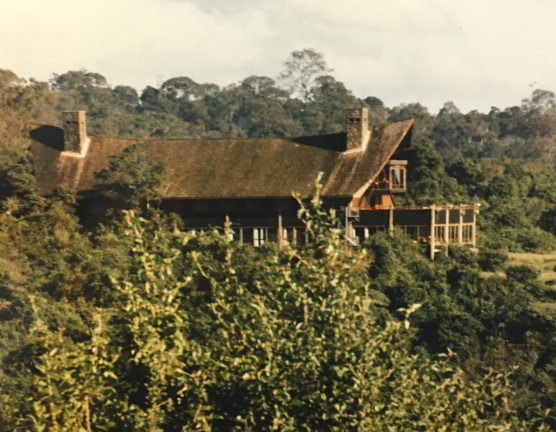

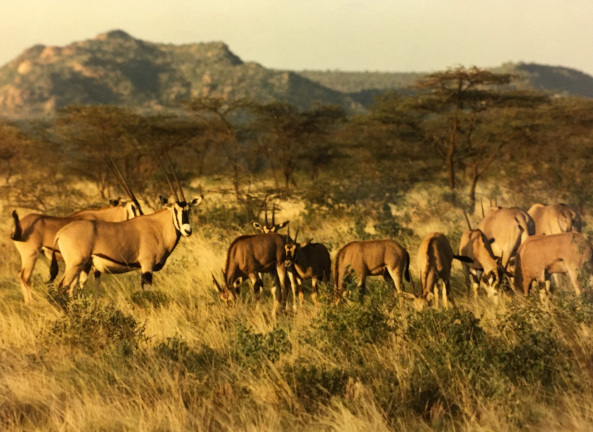

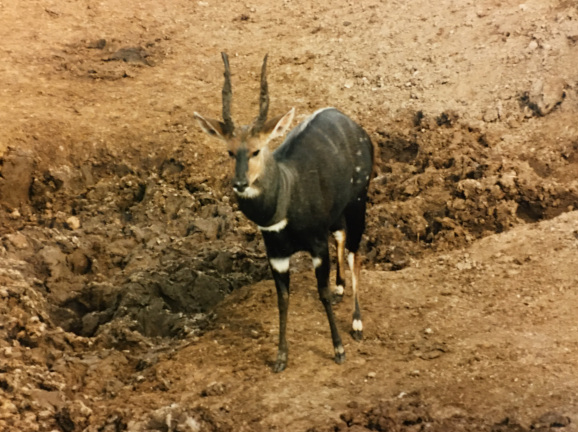
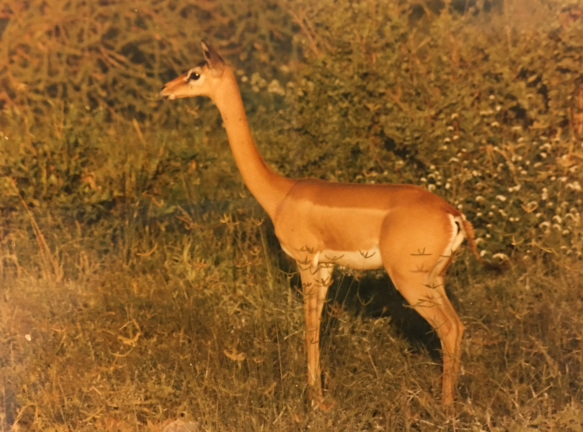

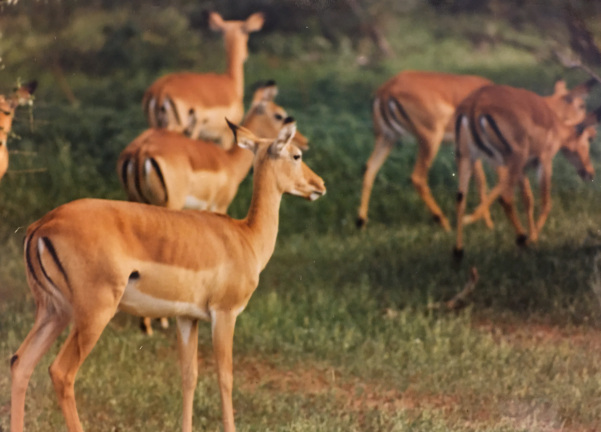
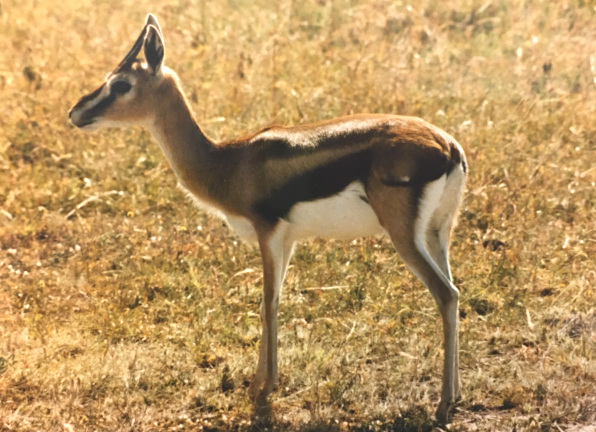



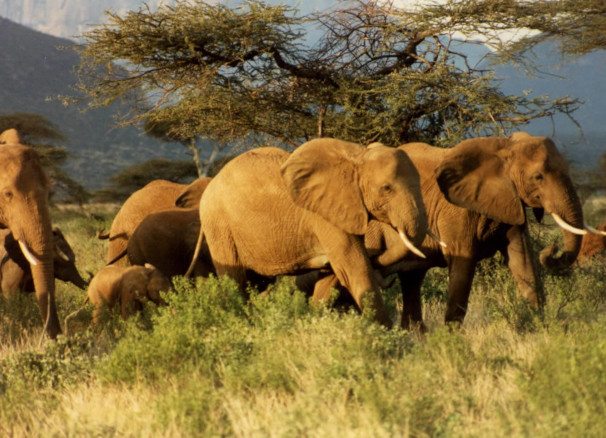

There are nine species of giraffe, each with differing markings. In Kenya the three species
found are:
The Masai Giraffe (most common, perhaps 15,000 individuals) located in Amboseli, Masai Mara, with
dark, irregular, jagged, star shaped blotches that extend to the hooves.
The Reticulated Giraffe
(aka Somali Giraffe) perhaps 8,000 individuals) located in northern Kenya (Samburu) with
clearly defined polygonal liver-colored spots, often dark, separated by bright white lines and a
pattern that may extend to the legs.
The Rothschild Giraffe (aka Ugandan Giraffe) perhaps 1,000 individuals) in protected areas of Kenya.
Markings similar to Masai Giraffe but less irregular and of lighter color, separated by a more cream
colored border. Legs are white.
On our trip, we saw the Somali Giraffe in Samburu and the Masai Giraffe in the Masai Mara.
The photo on the right, below, shows the two male lions being chased by young buffaloes as
described above.
There are three species of Zebra, two of which are found in Kenya:
The Plain’s Zebra (aka Burchell’s or Common Zebra) weighs about 450 – 550 pounds,
has a heavier body and shorter legs than the Grevy’s zebra and is found in the
south and east of Kenya (Masai Mara). It has wider stripes which cover the belly
and tend to be more curvy than those of the Grevy’s Zebra.
The Grevy’s Zebra is an endangered species found in northern Kenya (Samburu).
About 2,000 individuals remain of the 15,000 present in the 1970s.
It is larger (750-950 pounds) and taller than the Plain’s Zebra and has thinner
stripes which are straight, larger ears, and a white belly. The stripes do not extend across
the belly.
The third Zebra Species, the Mountain Zebra, is found in south and south-western Africa.
It is intermediate in size between the other two species and has a white belly like the Grevy’s Zebra.
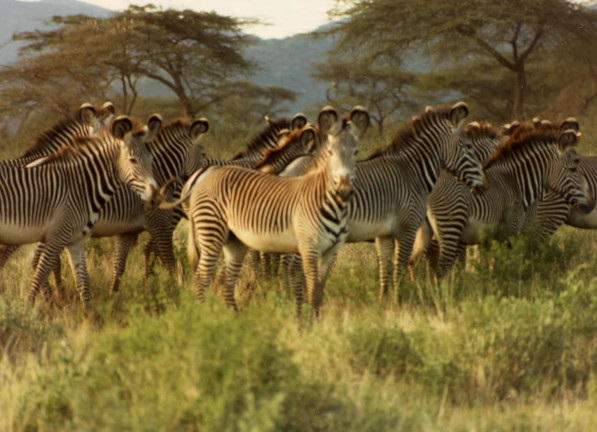

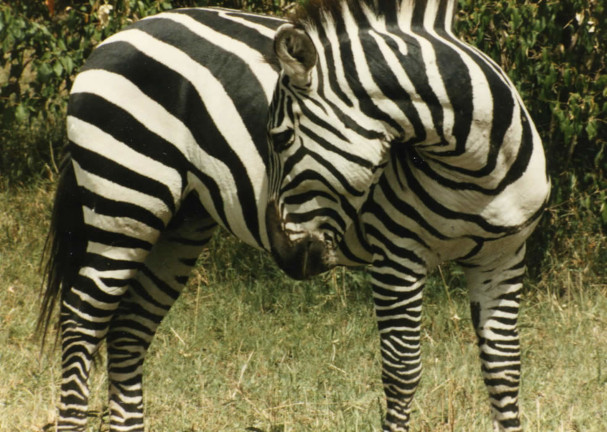

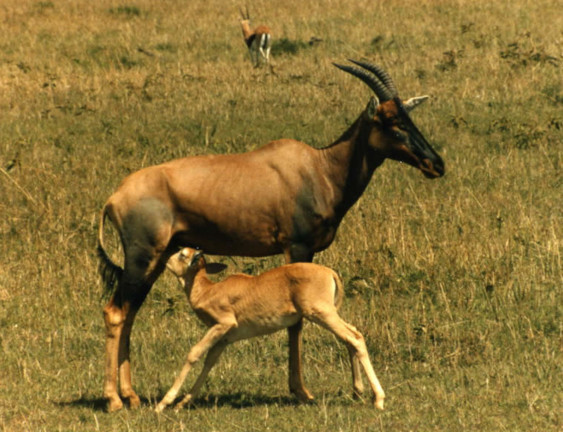
One of the more remarkable parts of our trip to Kenya was the
opportunity to visit a Masai women's village. Here are some pictures of the visit.
There is more information on the Masai and our visit above.
Other tourist photos from Kenya trip.
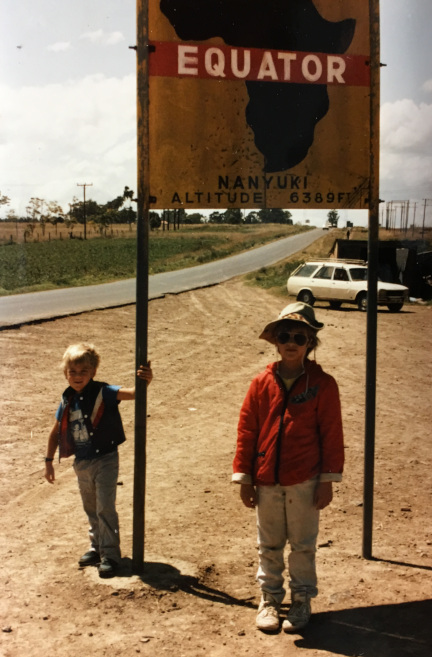
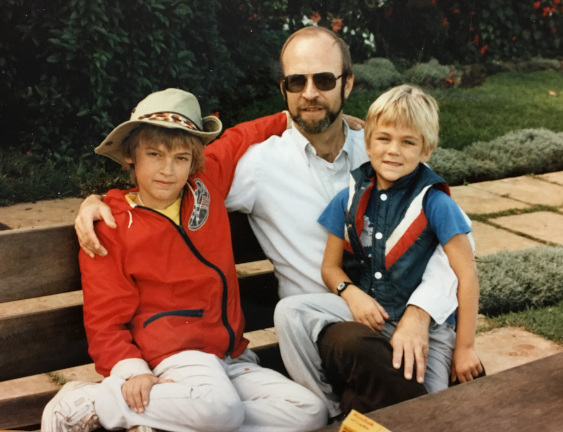
The US-Saudi Arabian Joint Economic Commission (JECOR)
JECOR is mentioned in the excellent book "Confessions of an Economic Hit Man" by John Perkins (2004),
which provides a truthful, if unfavorable, look at the organization, and some of the
shady aspects of its early days.
The origin stories that circulated among the "old hands" at JECOR during our tenure are helpful
in understanding how things really operated and the purpose of it all. In this version
of reality, the Joint Economic Commission was created during the "oil crisis"
of the late 1970s, when the price of oil skyrocketed and a massive flow of money
gushed into the little Kingdom of Saudi Arabia, and other oil-producing nations. The
transfer of wealth during that era rivals that of the flow of wealth (gold and silver) to Spain during
the conquest of the Americas. In the case of Spain, that nation embarked on an ill-fated
militarization and wars of conquest, with disastrous results, long and short term. In the
case of Saudi Arabia, the nation did not embark on military mis-adventures but rather
began an ambitious program of infrastructure building, reform of agriculture and
diversification of the economy, and huge social support programs.
In the case of Saudi Arabia, the reasons for it's not spending on a military build-up
extend back to the time between WW1 and WW2, when the new country of Saudi Arabia, a
"Kingdom", was largely ignored by the European powers, but was treated with respect
by the United States, particularly under Franklin Roosevelt's administration. During that
time, the Americans obtained a virtual exclusive lock on Saudi oil through the
joint venture "ARAMCO". Today's Saudi Aramco, also called Saudi Arabian Oil Company,
was formerly the Arabian American Oil Company, the oil company founded by the Standard Oil Company
of California (Chevron) in 1933, when the government of Saudi Arabia granted it a concession.
Other U.S. companies joined after oil was found near Dhahran in 1938.
In addition, later negociations between the two nations resulted in an agreement that
the US would protect Saudi Arabia if the later nation ever needed defending in a
military way. This agreement was in exchange for Saudi Arabia consenting not to build up its military. This
agreement was widely viewed as a protection for the new state of Israel.
Sometime during this massive transfer of wealth from the US to Saudi Arabia,
shortly after the 1973 Arab-Israeli war, American leadership,
in the person of Henry Kissinger, moved to develop improved relations with the Arab
nations. Since by that time, the price of oil had increased from about $1.39 per barrel to
$8.32 a barrel, there was also a need to find means to return these "petrodollars"
to the US, which was bleeding cash to the oil producing nations. The actual scheme
was developed and implemented by William Simon, the Treasury
Secretary during the Nixon and Ford administrations. That scheme was the Joint Economic Commission.
The Commission’s objectives at the time it was created:
“Its purposes will be to promote programs of industrialization, trade,
manpower training, agriculture, and science and technology.”
The participating Saudi government agencies were the
Ministry of Foreign Affairs, the Ministry of Finance and National Economy,
the Ministry of Commerce, and Industry, and the Ministry of Planning. On the US side,
the managing agency was Simon’s Treasury Department. This was an unusual arrangement,
because such international government to government assistance programs would fall
under the Agency for International Development, part of the State Department.
This difference was very
important as it placed the operations of the Joint Commission outside
the arena of diplomacy. As things evolved, there was little communication or cooperation
between the two US departments, Treasury and State. This was because the basic
issue was about money. Most non-military "foreign aid" is US
government funded with funds allocated by congress funneled through the State Department and
the Agency for International Development. In the case of the Joint Commission, the entire
cost of all the programs was borne by the Saudi Arabian government, and all the funds to support
the programs were transferred from the Saudi Ministy of Finance to the US Treasury Department each
year in advance of the annual program implementation. This was an extra-budgetary transfer of
billions of dollars without any congressional or other oversight. The Treasury Department then
administered the money and generally made certain that much of it flowed in ways that routed
into that department and its personnel.
The whole process was largely run through the Joint Commission office in Riyadh, JECOR, with
of course, plenty of supervison from an office in Washington created for that purpose and headed
by a "Deputy Under Secretary of the Treasury".
It was supposed to work something like this. When a Saudi government agency felt it needed
some manner of assistance from a counterpart U.S. government agency, JECOR staff would work
with the Saudi agency needing assistance to develop a "scope of work". JECOR then identified
a US government agency with the staff and expertise to address the stipulated
need(s), prepared a work plan and staffing requirement for the project, identified
necessary local resources and then worked up a budget for review and approval by the Saudi agency,
the Saudi Ministry of Finance, and the U.S. Treasury Department. Once the plan and budget
had been approved, the money was transferred to the US Treasury Department from the Saudi
Ministry of Finance. At Treasury all the JECOR money was kept in an
interest bearing account, with the interest earned being retained in the account.
It should be noted that money for a JECOR project was "extra budget" for the Saudi Agency as well.
Thus, there was incentive on both side to develop and implement projects.
There was a lot of money at play. Multiple billions of dollars. To get a sense of how much money
was involved, consider this "factoid". The Saudis finally pulled the plug on the Joint
Commission sometime around 2000 at the time the Kingdom began to first run significant deficit budgets,
(something JECOR planners had taught them how to do). Even the Saudis felt they could no longer
afford the Commission. The Joint Commission however continued to operate with money
remaining in the Treasury account. The accumulated interest on those prior budgets funded continued
operations for nearly ten years, at annual budgets of billions, as the various projects wound down.
And all that money was simply the interest earned on all the Saudi money that Treasury had kept on hand
through the decades before.
Throughout its existence, JECOR maintained a headquarters of its own, separate from the US Embassy
in Saudi Arabia. It managed an extensive network of support for the many projects (dozens) it operated
including housing for staff, both U.S. citizens and local workers. It operated a fleet of cars provided
to project staff as well as cars and drivers for staff and families, as the U. S. staff there were
in country with families and were provided full support from housing and transportation to schooling
for their children. It was a pretty cushy life and the increased pay and favorable tax regulations
made it a very good assignment for mid-level government employees.
The Saudi Military
There were plenty of U.S. military personnal in Saudi Arabia at the time we were there.
Many were there in a training capacity. There was a major training facility in Riyadh,
known to us as "USMTM" - for U. S. Military Training Mission. It was established in
1953. The trainers there dealt
with the Saudi Army and Air Force personnel.
Saudi Arabia at the time did not have much of an army. There was a small force, staffed largely
by paid personnel mostly from Pakistan, which operated the armored units that were part of
a defensive force. The Kingdom did have a small air force, flying American aircraft and
trained by American trainers, who privately told us that the Saudis made excellent pilots.
In addition, Saudi Arabia operated a fleet of AWACS (Airborne Warning and ControlSystem) aircraft.
These operated out of the military airport in the northern part of Riyadh, and there was one in the
sky at all times. Although the crew on the aircraft were Saudi, there was always a U.S. co-pilot
and electronic warfare specialist on board. It was rumored that intelligence from the Saudi AWACS
planes was shared not only with the U.S. but also with Israel.
The kingdom did however have a "National Guard". This was the personal army of the King made up entirely
of men from bedouin tribes which had pledged personal loyalty to the King, renewed every
year. This Guard was organized by tribe and service in it was voluntary. The Guard was trained by U.S.trainers
at a huge base just outside Riyadh, known as OPM/SANG, established in 1965.
Our project team got to know the health team at the hospital
there during our time of stitching together an emergency medical services system for the
area and coordinating ambulance care locally. The SANG hospital was an excellent top level trauma
center, due largely to the frequent training mishaps there.
It was the National Guard that defended the Grand Mosque in Mecca in 1987 during the attempted take over
of the shrine by Iranian backed Shia Muslims during the annual pilgrimage. Privately, we heard that
the Guardsmen had stood their ground against a huge, armed crowd, ultimately preventing the
entry into the mosque and killing large numbers of the crowd, despite heavy casualties of their own.
The American trainers we knew were very proud of their trainees and told us that there were over 1,200
people killed during the episode. That number has never been confirmed by any official source, and
the bodies were reputed to have been buried in mass graves in the desert and the individuals simply reported
as "missing".
One important principle of US - Saudi military cooperation was that there would be no US (or any
other foreign nation's) combat troops stationed within the Kingdom. This was a very important aspect
of the relationship and important to Saudi Arabian leadership to show their Arab neighbors that
the Kingdom was not a pawn of the United States.
This "understanding" was still very much inforce during our time there in the mid 1980s. The Iran-Iraq
war had greatly heightened security concerns in the region and there was a US Naval presence
in the Gulf. And the AWACS operated by the Saudis were an important part of efforts to
monitor and influence the outcome of the war. But, although
US personnel flew aboard the AWACS aircraft, for example, they were in the Kingdom for short term
roations, about 6 weeks, not permanently stationed there. The only long term US military personnel
were trainers.
Things changed with the Iraq invasion of Kuwait in 1990. U.S. President Bush's administration
prevailed upon the King of Saudi Arabia to allow U.S. combat operations within the Kingdom. Although
the agreement to permit this was short term, until the expulsion of Iraqi forces from Kuwait,
on-going concerns about Iraq's intentions prolonged the stay. This presence of U.S. forces
and the behaviors of U.S. troops, who were not always sensitive to the conservative traditions
of the Saudi populace, led to a strengthening of the deeply conservative fundamentalist
Islamic Sunni factions in the Kingdom. These people had always been critical of the royal
family, mostly for their "western" ways and their opulent lifestyle, but the criticism
gained little traction among most of the population, who enjoyed relative economic prosperity
and security through the policies of the government. But the tensions around the presence
of foreign combat forces shifted the dynamic and resulted in increasing support for the
most conservative elements in Saudi society.
That shift in societal attitudes about "Americans" coupled with the return to the Kingdom
of Saudi nationals, who had fought with the "Mujahideen" in Afghanistan against the
Soviets and the Soviet-backed Afghan government during 1980 - 1990 created fertile
soil for a home-grown, Saudi led, Sunni Islamic fundamentalist movement. The Saudi
government had always had a somewhat uneasy relationship with the more conservative
elements of the society, the Wahhabi, but found itself faced with a new fundamentalist
movement prepared to use terrorist tactics to bring about the downfall of the royal
family government and the expulsion of all foreign troops from the country. And this
new movement had plenty of participants who had combat training (mostly by the U.S.)
and experience in Afghanistan. And, as well, they had a network of contacts with
like-minded people outside the Kingdom. The mix proved to be deadly and led to the
1995 car bomb attack on the headquarters of OPM/SANG in Riyadh, killing 7 and wounding 70,
the 1996 truck bombing of the military facility at Khobar Towers killing 19 and wounding
over 400 and later in the 2001
attacks on the World Trade Center towers and the Pentagon.
What's in a name?
In the Arab world, it is said you can tell all you need to know about
a man from his name.
In general, a person has a personal name or names and a family or tribal name.
For example, the name Mohammed Ghatani or Mohammed Al-Ghatani, identified
the person as Mohammed from the family (clan, tribe) the Ghatani. Note
that the name Ghatani is also transliterated/spelled as Qahtani.
In Saudi Arabia, most people know which tribes pledged loyalty to
the founding king, Abdul-Azziz, "Ibn Saud", and if you are a member of
one of the earliest families to do so, you are regarded with greater
respect and regarded as more trustworthy.
Also, many names are associated with particualar regions of the country
there. In the example above, the Ghatani (Qahtani) are a people from the south-
western part of Saudi Arabia, in the Tihamah, the coastal plain, or
the Asir, the mountains there. The Ghatani are found both in Saudi
Arabia and adjacent North Yemen.
To further identify an individual, the name may include the
name of the persons father as part of the individual's name.
The first king of Saudi Arabia was named
Abdul Azziz bin Abdul Rahman Al Saud. Which roughly
translates as "Abdul Azziz, son of Abdul Rahman, of the Saud
family". Women can be identified similarly. The mother of
Abdul Azziz, wife of Abdul Rahman, was named Sara bint
Ahmed Al Sudairi. This translates as "Sara, daughter of
Ahmed of the Sudairi family".
King Abdul Azziz had multiple wives, one of which was
Hussa bint Ahmed Al Sudairi. He had more
sons with Hussa than he did with any of his other wives.
Although the King had a total of 45 sons of which about
36 survived to adulthood along with many daughters,
the seven sons with Hussa are known as "The Sudairi Seven".
Although only two of the seven have become King,
Fahad and Salman, the group has been and remains
extremely important and influential in royal politics.
Complicating things a bit is the common use of nicknames
for Arab men and women. The first King Abdul Azziz, for
example, was frequently known as "Ibn Saud". Ibn is a
variant of "bin", so this roughly translates as "Son of Saud".
Another common alternative name, nickname, uses the word
"Abu", which means "father of". So a man with an eldest son
named Khalid might be known as "Abu Khalid".
First names are often aspirational, based on some hoped-for
characteristic, or the Arabic equivalent of the name of a
character in the Bible or the Quoran. Abdullah, for example,
means "servant of God". Mahmoud means "Worthy of Praise". Hamdi
has a similar meaning, but also means "one who remains close or
steadfast". Saifan means "Sword of Allah". There are feminine
equivalents for all these as well as humdreds of other names
for girls. Aliya (Gift of God), Jamilah (Lovely), Fatima (Captivating,
also, one of Mohammed's daughters) and so forth.
Also, there are biblical names such
as Ibrahim (Abraham), Yusif (Joseph), Daoud (David) for
boys and Sara (Sarah) or Mariam (Mary) for girls.
And, of course, within families, or among friends, individuals
have other names, based on some characteristic or behavior.
Ibrahim is often shortened to "Brahim", for example.
Christian Arabs often use different first names or
variations of spelling of the names. Also, there are
different ways of saying "son of" or "father of" among
Christian Arabs. Use of the connector "Abi", such as in
Daoud Abi-Nader, indicates the person is a Christian, likely
from Lebanon or Syria.
In a conversation with a physician colleague at the
American Embassy in Riyadh, he played the Middle Eastern
"name game" with me. His name was Daoud Kantalflas and
he asked me to tell him the origin of the name, and thus
his birthplace. The first name was Daoud, the Arabic for
David. The family name Kantalflas, was of Greek Origin
and refers to the "candle-lighter" in Orthodox Church
services. An Arabic first name and a family name of
Eastern Orthodox origin? He was from Jerusalem, born
there before the 1947 war in the days when people of
all faiths and all ethnic origins and all nations lived
there and co-existed peacefully.
I once met a man with the last name / family name of
"Al-Andes" and we talked for a while, going back some
generations to trace the names to see if there was some
connection. Our name is a version of a name found in Germany
and spelled variously in the U.S. as Andes, Antes, Andis,
Antis. Although there are hints in the family oral history that
it may have originated in ancient "Gaul". Caesar's Gallic
Commentary mentions a tribe by that name, the Andes. My
Arabic acquaintance however, traced the origin of his
family name back only for a few generations, to a grandfather,
or perhaps a great grandfather, who acquired the name as a
nickname as a child. It meant something like crybaby or
one who fusses a lot as a child. The name stuck, and his
progeny then became the Al-Andes tribe.
Two quick thoughts on the Arabic language releated to
names and the origin of names.
The definitive article in Arabic is usually transiterated
as "Al" in English. So in the story above, the tribe
mentioned would be the Al-Andes. If you refer to the door,
it is Al-Bab. And God is Al-Lah (The God, the One God).
But the definitive article changes when the word following
it starts with an S or an R. So, the city of Riyadh is
actually spoken or written as Ar-Riyadh. And the family
name Sughair would be As-Sughair, not Al-Sughair. So, to
be strictly correct, the royal family name would be As-Saud,
not Al-Saud, although the latter is more commonly used, even
in Saudi Arabia.
Also among Arabic speakers, there is a different time sense than
among westerners. This is perhaps a function of the language, which
indicates future tense and past tense by adding a prefix to
the root stem of the present tense. The past tense is amost
always a past pefect tense, indicating the action has been
completed. Also, verbs are modified to reflect such things
as mood, active or passive voice, and others. Sometimes the
differences are subtle, such as the doubling of a letter or
using a different vowel, and sometimes there is no difference
in how the word is written, only in pronounciation. Because
everyday written Arabic includes only the consonants and
omits the vowels, it renders the language somewhat imprecise
at times. Only in the Koran are all the vowel markings always
present, as the language in the Koran is not to be misunderstood.
So, spoken Arabic often omits or elides some of the verb
prefixes and suffixes and speakers tend to use the present
tense stem of a verb in casual conversation. This practice
often slides over to the English used by a native Arabic
speaker. So we learned that when a Saudi colleague at work
described some event seen on the street on the way to work,
he may be talking about something that had happened to him
that morning, something that had happened to him at some
time in the past, or something that had happened to a
friend or relative today or sometime in the past. This
different sense of time is an important thing to remember
about the Arabic culture. It keeps the past fresh and
part of daily life. And also keeps alive past wrongs or
grievances from generations ago.
Remember that most Arabic Muslims can recite the names of
their direct ancestors all the way back to the time of
the Prophet, Mohammed.
Saudi Traditions - Origins and Changes in Culture
One day at the Red Crescent headquarters, the chief of the
neurosurgery department arrived for an EMS planning meeting. We
were chatting before the meeting and he shared with me that he
had recently taken a bus in Riyadh and had been surprised
to see several people on the bus reading the local paper and was
delighted by this. I did comprehend his happiness over such a
simple and, to me, commonplace thing. He explained that many
aspects of Saudi culture and customs were rooted in the nomadic
life style of earlier generations. Nomads don't have books,
other than a Koran, because they are so heavy to carry about.
They don't have furniture, either, which will lead to the
next paragraph. Although the literacy
rate in Saudi Arabia was pretty high, most people still had
not developed a habit of reading. So my acquaintance
had been very happy and
hopeful to see ordinary Saudis reading the paper on the bus.
Something, he said, that he would not have seen even a year or
two earlier.
Probably for similar reasons, in the more traditional Saudi homes,
there was little furniture. In what would correspong to
the living room, the "maglis" or
sitting room as it was known, where the men hung out when
visitors came, most homes were furnished with carpets on
carpets and large bolsters and pillows along the walls. You
can see two examples of a sitting room above in the section
about Saudi hospitality. In the adjacent room, often separated
from the Maglis by a set of double doors or pocket doors, the
dining room was also sparsley furnished. There was no dining
room table and chairs, as meals were served on great trays placed
on the carpeted floor and people sat on small cushions to eat.
In homes of more "westernized" Saudis or homes of Saudis who
frequently entertained westerners, the furnishings were much
the same as in an American home, with large couches, chairs,
"coffee tables", lamps, etageres, knick-knacks, and sometimes
family pictures. Dining rooms had large tables with chairs,
side boards, and so forth, and meals were served individually
with guests seated at the table, provided with plates, and
all the knives, forks, and spoons you would find at home.
Sometimes, when dining in a traditional home, or when eating
Kebsa on a camping trip, one might be offered a spoon, or
find one discreetly placed just to the right hand of where
the host was to sit, the spot where you, as honored guest,
were to sit. It was a point of pride to either decline the
proffered spoon, or ignore the spoon found at your seat. On
some occasions, the host might select the best, most tender
and tasty portions of the meal and hand them to you. This
was a way of honoring the guest.
In many respects, the ordinary Saudis tend to look back on
their former desert life through a romantic lens. Saudi families
commonly go camping or picnic in the desert around Riyadh, perhaps
to capture some of this remembered past. Even though few
Saudis today were true nomads, Bedouin, the desert and
the severity of life in a desert setting permeated every
aspect of life in the Kingdom for many generations. Even
the Saudis who lived in their cities interacted and
interfaced constantly with the desert and desert dwellers.
Even those who lived and farmed in the fertile
coastal plains in the west or fished the Red Sea or
the Gulf, always lived a precarious existance.
There are other ways in which the early history of
survival in the desert affects the culture. The generous
hospitality of Saudis, the sharing of food, and the genuine
desire that a guest be taken care of to the best of the
host's ability probably stem from the basic need to take
care of other people, even strangers, when in the hostile
environment of the desert. It is said in Saudi Arabia, that
if you are camped in the desert and a stranger approaches you,
it is your duty to provide the stranger with food and water and
rest for three days. At the end of the third day, it is permitted
to ask politely whether the stranger will need any provisions
to continue his journey. This hospitality is to be offered
even if the host recognizes that the stranger is in fact
a mortal enemy or member of an enemy clan.
In warfare, there was another tradition. Should a raiding party
fall upon an encampment of an enemy clan, it was permissible for
the raiders to kill all males over the age of ten or so, but the
women and female children and males under the age of ten were to
be spared. And when the raiders departed, they were to leave
three days of food and water for the survivors they left behind.
One could certainly question whether either of these storied
traditions were ever honored, but both seem to support the
notion that life in such a difficult and hostile environment
would certainly affect how even enemies treated each other and
that there must have been some honor code about that. After all,
westerners still accept the concept of chivalry in the
middle ages and many nations subscribe to the Geneva Conventions
about the conduct of modern warfare.
Security in Saudi Arabia
Saudi Arabia is a Muslim nation. Official statistics state that
the population is 100% Muslim, with 85-90% being Sunni and the remaining
10-15% Shia. But this number reflects only the number of Saudi
citizens, and of the reported 34 million population in 2021, a
number likely exaggerated, some 25 to 35% are foreign workers. That
number also is questionable and varies considerably depending on the
source. Saudi sources, for example, report there are about 1 to 1.5
million Pakistanis in the Kingdom; Pakistani sources put the number
at 2.5 million.
The actual population of the nation is regarded by the
government as a security issue.
Saudi Arabia exits in an unstable region and has neighbors that are
fundamentally not friendly to the Kingdom for several reasons. First,
the nation has plenty of oil and has developed and sold its oil
through alliances with western nations. Second, much of the money
from the sale of oil has benefited the royal family, which lives,
for the most part, a life of opulance that is hard to imagine. Third,
the Kingdom had not developed a large military and did not participate
with other Arab nations in military campaigns against Israel. Fourth,
the Saudi government, which is basically the royal family, constantly
reminds Muslims world wide that the two holiest sites in Islam, Mecca
and Medina, are in Saudi Arabia, a very sore topic with
Shia Muslims, who have vowed to take the holy sites from the
Saudis, who are Sunni Muslim. And the Kingdom is thought to profit
greatly from the annual Haaj pilgrimage, which all Muslims,
Sunni and Shia are to perform. And Fifth, Saudis are
generally perceived as arrogant and rude when traveling abroad,
especially in the Middle East but also in areas of Europe where
other Arabic people live or vacation. Saudis are, in fact, known
as the "Americans of the Middle East", which is not a compliment.
So, because of the fundamentally hostile environment that
the Kingdom exists in, the Saudi population numbers have been
inflated for years. During the JECOR years, there was a
data processing and statistical analysis project, STADAP.
That project was also charged with conducting a census and
reporting the results to the government. The initial count sometime
in 1985-86 showed
a population of Saudis around 1 to 2 million and a similar, perhaps
larger number of foreign workers. Discussions with the royal
family and government officials negociated the final figure upward
to a Saudi population of around 6 million and fewer foreign workers
but even today, total population is reported as around 12 million.
The actual Saudi population was a very sensitive security issue then
and I suspect it is today. In 1985, Iraq had a population of 15 million
(today around 45 million) and Iran had a population of 45 million
(85 million today). Iraq has a significant Shia population, about
60% of total population, concentrated in the southern areas, near
the Gulf, and Iran is almost entirely Shia Muslim.
Whatever the actual population of Saudi citizens is, some
10 to 15% of them are Shia Muslims. The Shia population is concentrated
in the Eastern Province, where most of the active oil fields
and refineries are located and where many of the foreign workers
from the U.S. and Europe are located, and where the Saudi Shia
population is subjected to pretty constant propaganda from
Iranian sources just across the Gulf. Thus, the Eastern Province
is and was regarded as the most potentially unstable in the
Kingdom, and the greatest security risks were thought to likely
arise there.
However, due to several factors, the security risks and actual
attempts to bring down the Saudi government in the 21st century
arose internally among Sunni Muslims. This was probably for
several reasons.
First, as mentioned above, there is and was
some resentment of the royal family among ordinary Saudis. This
resentment was ameliorated to large degree, at least during the
time we lived there, by the very generous welfare state created
by the government. But, as oil revenues changed and costs of
defense increased in the 1990s, the generosity of the welfare
state subsided. That, together with the significant growth
of the population, including the royal family, decreased the
share of government largess available for each ordinary family
while the royal families took and increasing share due simply
to there being more royals to take care of. This resentment
of the royal family, which is synonymous with the government,
was exploited by the Shia factions, who criticized the royals
for their life style, even for distributing pictures of the
King, which to them were forbidden "graven images", and for
the way the minority Shia were treated. And the resentment was
also exploited by the growing fundamentalist Sunni factions, who
criticized the royal family for their "western" ways, for
their alliances with the U.S., and for the continuing
presence of U.S. military forces in the Kingdom.
Saudi Arabia had come into existence in part through the
cooperation and collaboration between the original King, Ibn
Saud, and his family, and the members of a fundamentalist Sunni
Muslim sect, the Wahhabi. This cozy relationship was well-managed
by Ibn Saud's successors through the 1980s, but began to cool
in the 1990s. The U.S. (CIA directed) support for guerilla
forces in Afghanistan
resisting the invading forces of the Soviet Union was a
complicating factor and greatly affected Saudi security in
later years. These guerilla forces included large numbers
of Arab Muslim fighters, known as "Mujhideen", who recieved
military training and weapons from CIA trainers at bases
in Pakistan. Many Mujhideen were from Saudi Arabia and
returned home having had training and experience in
battle and also having had, either before or during their
time in Afghanistan, exposure to fundamentalist
Sunni Muslim doctrine. These returing fighters made
up a core of anti-government activists who soon
engaged in a domestic terror campaign in the Kingdom.
The U.S. support for and training of Saudi Mujhideen had
was a profound additional destabilizing factor for the
internal security of Saudi Arabia.
A significant second factor in increasing unrest among
the Saudi population was the combination of several things, both
unintended consequences of otherwise beneficial social programs.
The Saudi government had encouraged population growth among
Saudi citizens for years through generous social support systems
including housing, food and water assistance,
free healthcare, and other benefits that enabled large
families. The Kingdom had always had a high birth rate.
The Saudi birth rate was 47 live births per thousand
population in 1960 (U.S. was 22), 43 in 1980 (U.S. 15)
and that, together with medical services that reduced the
infant and child death rate and prolonged life, further
increased the size of the Saudi population. The Saudi
birth rate in 2000 was 17 (U.S. 12), probably reflecting
social and economic factors mentioned above that made larger
families less affordable.
During the mid and late
20th century, the Saudi government also implemented an
educational system that provided free
education through graduate school for all Saudis.
This free education included support for
study abroad, including tuition and living expenses, for
the student and his/her family. Many Saudis we met in
the 1980s had been educated at U.S. or European universities.
These students returned with an excellent education
and with fond memories of student days abroad, an
understanding of western culture, and friends in
western nations. In the late 1980s, the Saudi
government almost entirely ended its support for
advanced study abroad both as a cost saving measure
and because the internal Saudi university systems had
developed to a point where they were regarded as
equivalent to any in other nations. Thus, by the
1990s, Saudis with advanced degrees were likely to
have studied in Kingdom and not have experienced
student life abroad.
The educational system produced increasing numbers
of highly educated Saudis. But there were not enough jobs for
them in Saudi Arabia There were, for example, excellent petroleum
engineering programs at multiple universities in
Saudi Arabia, turning out thousands of graduates
per year. But how many petroleum engineers can a
nation employ?
In short, through generous, well intentioned, social
programs to enlarge and benefit the general population, Saudi Arabia
produced an increasing number of highly educated people
(men and women) with high expectations for a well-paying
career at home, who could not find a job. An excellent
population for exploitation by those creating or
fostering discontent and division.
Naturally, the Saudi government took security seriously. And,
according to American security personnel with whom I spoke,
they were really, really good at it.
For example, in our project, some of the personnel
came to me with
concerns about a fellow from Palestine who worked for
JECOR and was talking about how difficult life was for
Palestinians living in the West Bank due to Israeli
government policies and actions. This fellow even shared
some literature with them that had originated with the
Palestine Liberation Organization, considered a
terrorist organization by the U.S. government. At their
request, I reviewed the situation with the security
people at the American Embassy. They were not concerned
about
the report, saying that they (Americans) did not
worry at all about Palestinians. This was for two reasons.
First, most Palestinians were intensely pro-American and
were simply hoping that some day the U.S. would
realize the situation in Palestine and force Israel to
do the right thing. And second, the Saudi security
people already closely monitored all Palestinians in the
Kingdom. The Saudis even collected a sort of tax from
the salaries of Palestiniand and forwarded it to the PLO,
so the relationship was a good one.
It was the Pakistanis that the Saudis and the
American security personnel worried about. And, in
fact, the several small bombings that happend in Riyadh
during our time there were all perpetrated by Pakistanis.
A couple of them were thought to have been directed at
Americans, as they happened at places frequented by
Americans, such as a pizza restaurant.
In addition, there were three kinds of police in Saudi Arabia, not
including military and customs and immigration police.
There were the Security Police, the General Police (including
Traffic Police), and the Society for the Prevention of
Vice and the Promotion of Virtue ("Mutawah"), the Religious
Police. The latter had little enforcement authority, but
could make life pretty miserable for Saudis and for
other Muslims. They had little they could do to
harass westerers, other than verbally. The Traffic Police
are discussed further below in the section on
Law and Lawyers in Saudi Arabia.
The Security Police today are part of
the Saudi Mabahith or General Investigation Directorate, which
was created in 2017 by merging the domestic security agency
and the counter-terrorism agency, perhaps a recognition of
the growing threat of home-grown terrorism. This Directorate
has Ministry level authority.
The Saudi Security Police are a secret police.
The officers of the Mabahith have the authority to investigate,
surveil, arrest, and detain individuals who are deemed to be "threats to
national security". The definition of a threat to national security
has enlarged over the years to include not only terrorists
but also members of the political opposition. The Mabahith
is thought to operate several prisons in the country, which
are separate from the general criminal prison system. The
power of the Security Police has increased over the years
since we lived there, paralleling the increase in threat of
terrorism within and without the country.
Fortunately, we had no contact with the Security Police while
we were there.
Law (Shari'ah) and Lawyers in Saudi Arabia
Criminal Law Inforcement
The General Police in Saudi Arabia are part of
the Directorate of Police or Public Security, part
of the Ministry of the Interior. These are civilian officers
responsible for law enforcement in the Kingdom.
The General Police force has several operating Departments:
The Police Department deals with ordinary criminial matters
and operates much as similar organizations in other countries.
They refer arrested individuals to the court system for prosecution.
The Saudi legal system, including the courts,is based on Shari'ah,
the body Islamic laws
derived from the Qur'an and the Sunnah (the traditions) of the
Islamic Prophet Muhammad. Shari'ah also includes Islamic
scholarly opinion (Ijma) developed after Muhammad's death, but lacks
the tradition of judicial precedent that is a cornerstone of
American "common law". Most trials or court appearances in
Saudi Arabia are "bench hearings", that is, the accused appears
before a judge, who makes the decision in the case. This lack
of the tradition of a jury trial, a trial by ones peers, is
a second big difference between Sharia and the American system
of law.
These differences mean that a decision in any individual case
is made by a "judge" who bases the decision on his understanding
of Shari'ah law together with any mitigating circumstances. There
are few standardized procedures and an accused is not always
represented by a lawyer. Most cases,
both civil and criminal, are seen in a Shari'ah Court. The Saudi court
system consists of three main parts. The largest is
the Shari’ah Courts, which hear most cases in the Saudi legal system.
Reforms to the judicial system in the 1990s and 2000s created
administrative courts, and courts dealing with labor issues, and
other specialized areas, and
a Supreme Judicial Council. But the King remains the final, highest,
"court of appeal" and source of pardons.
Also, within agencies and Ministries, there were and are separate
councils and individuals to ajudicated certain disputes or matters
within the jurisdiction of the agency. More on that in the
discussion of the Traffic Police.
So the Police Department officers dealt with violations of
criminal law. The crimes varied from relatively minor
crimes such as fighting though more serious things such as
petty theft to serious crimes such as murder. Criminal law punishments
could be very serious and include(d) public beheading,
stoning, amputation and lashing. Serious criminal offences included
not only crimes such as murder, rape, theft and
robbery, but also apostasy, adultery, witchcraft and sorcery.
While we were there, public beheadings were less common that
recent years, when excution of "terrorists" and dissidents has
increased. Many executions were for non-violent crimes, drug
use or drug smuggling being a common capital offense. During
our time, two men were arrested for stealing gold from the safe
of a gold merchant in the market in Riyadh. Although it was said
publically that a death sentence only was given for serious crimes
such as murder or rape, it was also given to individuals who
were "habitual criminals". In the case of the gold thiefs in
Riyadh, they were accused of "crime against the national economy"
and one was determined to be a habitual criminal, as he had
several parking tickets on his record. The latter one was beheaded.
One of our Saudi EMS trainers had worked for a time as an ambulance
attendant and nurse and had attended several public executions and
ambutations. According to him, the persons being beheaded were
heavily drugged and sedated before the execution, to the point where
they needed assistance even walking to the execution site. Once they
had knelt before the swordsman, the death came quickly. Those having
a hand amuputated for habitual thievery were also sedated, and a
physician marked a line on the wrist where the swordsman was to
make the cut. After the amputation, the amputee was further medicated,
taken to hospital by ambulance, and the amputation surgically
completed in the operating room by surgeons.
I also talked with other western health care workers stationed in
rural areas and learned they had witnessed (fatal) public stoning of a woman
accused of adultery.
Cautionary tales about biblical punishments as they exist in a
present day theocracy, where there is no separation of church and state.
Civil Law, Lawyers, and Contracts in Saudi Arabia
One consequence of the way the legal system functioned, was
that, at least in the 1980s, there were few lawyers in Saudi
Arabia. Whether this was a good thing or a bad thing might be
debated, but there were a couple of consequences that affected
our work and function when we were there. One is the way the
traffic laws were enforced, discussed below, the other is
the many problems that developed around contracts there.
It was said around JECOR, and among other "old hands" with
experience in the Middle East, that "to an Arab (Saudi), the
signing of a contract was the signal to begin negociations."
A contract was to a westerner, an iron-clad, legally binding,
document which stipulated in detail the obligations of the
parties to the contract. On the other hand, to a Saudi,
individual or organization, a contract was just an agreement
between or among the parties that they would be doing business
together for some specified time and the details of what that
business might entail would be worked out later.
This cultural difference in understanding what a contract
was, in the most elemental way, was a constant, daily issue
in the administration of our project there. We had a protracted
annual budgeting process involving the parties on the American
side, JECOR, the Public Health Service, Medical Care Development,
and the team in the field and the parties on the Saudi side,
the officials of the Red Crescent Society at multiple levels with
whom we worked. All the involved parties had expectations and
budget input. Once all the parties had signed off on the budget,
the work plan, the goals and objectives of the project, and the
time line for delivery, we westerners thought everything was
settled and we could begin the work year with a clear work plan.
But within a day of so of the signing of the contract, I would
be dealing with a President or Vice President or Director who
wished some additional task or tasks to be added to the work of
the team. It was perhaps a function of the exaggerated idea on
the Saudi side of what our team members were capable of, as
they did pretty consistently perform miracles, but it was
more likely that simple cultural difference in understanding
what a contract is.
In American law a contract is a pretty sacred document and
enforceable through the legal system. In Saudi Arabia, that
was not the case. There were few lawyers there with any
experience in contract law and the courts approached issues
around contracts very differently. The issues and misunderstandings
around contracts were important when we were there and
the continued, although there was at the time, a genuine
effort to train Saudis as lawyers specializing in contract law.
Today, there are probably many lawyers there, an improvement,
no doubt.
Traffic Law Enforcement
The Traffic Department is a second part of the General Police.
These officers were in charge of enforcing the traffic laws
of the Kingdom. Since there were many drivers from many different
countries, driving habits were spectacularly different from what
we were accustomed to in the U.S. There was, for a time, a
document circulating at JECOR titled, "Traffic Laws of the
Kingdom of Saudi Arabia as Empirically Derived". It was simply
a list of the more bizarre driving behaviors seen frequently there.
The "No U Turn on Red" sign mentioned above is one.
The Traffic Police patrolled the city and arrested drivers whom
they saw violating some traffic law. There was no further evidence
needed for the arrest other than the word of the Police officer
because, as it was said "Why would the officer lie? Arresting
someone only makes more paperwork for the officer." And since
people are basically lazy, it is presumed that no rational person
would voluntarily increase his workload.
So, if a Traffic Police Officer saw someone driving through a red light,
the officer would arrest the driver, who would leave his car by
the road and sit in the back of the police cruiser until the
arresting officer had filled up his car and would then take
the arrestees to the police station to be jailed until seen
by an administrative judge, also a police officer, and a fine
or other penalty assigned. Once the fine was determined, the
arrested driver would remain in jail until someone from the
family or a friend or a colleague came to the police station to
pay the fine. Saudi jails provided no meals to prisoners, so the
families also had to provide meals as long as the driver was
incarcerated.
One of our team was arrested on the way to work for allegedly
driving through a stop sign or a red light. After some hours riding
around in the police cruiser, he was taken to the local police station
and jailed. There was no right to a "phone call" there, the people
in the jail had access to a phone on a first grab basis during the
times the jail staff was at prayer, so
when he did not show up at the office, we had no way of knowing
what had happened. Fortunately, another worker in the building
had passed by as our man was being arrested and let us know
what he had seen. We sent the JECOR "expediter" out to find the
car, which gave him a clue as to which police station our
man would be jailed in, and he was thus able to track him
down. Unfortunately, it was late in the day and the arresting
officer had gone home after his shift, so the "judge" could not
make a decision and assign a fine until the next day, so
our man spent a night in jail.
Fortunately, our team member had a great sense of humor, or
at least appreciated absurdity, and took the entire epsisode in
stride. He told us that the evening meal was a pretty impressive
international smorgasbord of meals prepared by the families of
all the incarcerated drivers awaiting "trial". The drivers all
shared their food with other arrestees. The only negative thing
about that night, was when the police brought in a bus load of
arrestees and the holding cell became standing room only.
The next day, the "judge" held a hearing and assigned a fine of
three hundred Saudi riyals (just under $100). When the JECOR expediter
questioned why the large fine, the judge replied "He is an American.
He should know better how to drive." Fine paid. Homeward bound.
The Traffic Police were also responsible for adjudicating traffic
accidents or crashed. When there was not any bodily injury drivers
in Saudi Arabia were expected to work things out between themselves.
One time, for example, as I was backing out of a parking space in
a strip mall, a Saudi cutting through the parking lot struck the
rear bumper of my "heavy Chevy". There was no damage to my car, but
the other car had its bumper torn off by the impact. The bumper was
lying on the pavement, in fact. My Arabic was not up to the rather
frenetic conversations that followed among myself, the other driver,
and his two passengers, so I immediately called the JECOR expediter,
who arrived in a few minutes. After about 15 minutes or so of more
conversation, the expediter announced that a decision had been
reached. The decision was that neither driver had intended for this
to happen, that it was truly an "accident" and no one was at fault.
Since the other car had suffered all the damage, however, it was
only reasonable that the two drivers share the cost of repairing
the other car. That would be 300 Riyals each. Done.
Should we not have been able to reach an agreement and finalize the
matter, or if the damage was more severe and the parties not able to
settle up financially, the Traffic Police responsible for accidents
would be called. Or perhaps just show up. These officers were
authorized to make a determination of who was at fault in the accident
and the extent (amount) of damages. If, for example, the officer decided
that driver A was at fault and the damage was 2,000 Riyals, the officer
would expect that driver A would pay driver B the 2,000 Riyals on the spot.
If driver A did not have the money to pay the assigned damages, he
would be taken to jail, where he would remain until family, friend, or
colleague brought the money to the jail and it was given to driver B.
It was an interesting system which eliminated the need for lawyers but
depended on the fundamental honesty of the Traffic Police. We did not
hear of any abuses or corruption among those officers, but then, we
probably would not have heard of it anyway. We, as JECOR sponsored
personnel had easy access to our "expediters", who were fluent Arabic
speakers and traveled with large amounts of cash to settle things
to everyone's satisfaction. We also traveled with hundreds of Riyals in
the glove box to settle up traffic accidents.
The General Police also included several other Departments, but we
had little interaction with them. And, fortunately, little with
the Traffic Police or the regular Police, either. There were a few
encounters with Religious Police, usually about how a woman we were
with was dressed, but these were generally benign.
On one occasion, I was with a colleague and his teen-aged daughter.
The daughter was dressed appropriately, in a long sleeved, ankle length
dress buttoned to the neck, and wearing a small scarf over her hair.
But her hair was long, and was worn down, so it was visible. As we
entered the old souk in Riyadh, we were stopped and cautioned by a
very polite young man, Mutawah, speaking excellent English, who
pointed out that the uncovered hair was a problem. Thinking fast,
I explained that we were on the way into the market to buy an Abaya
for the lady. The Abaya is the cloak that covers a woman from head to
toe and can be wrapped around the body to cover even the clothing.
It does not have a veil, but western women are not required to veil.
The young Mutawah appeared relieved by our explanation and
recommended a store for us, and, as I recall, even showed us
the way to it. And yes, we did buy the Abaya. All well in the end.
Equality in Saudi Arabia, Other Myths, Stories, Odds and Ends"
Islam teaches that all men are equal before God. During the Haaj, for example,
all the pilgrims wear the same white dress.
When making the pilgrimage, Muslims shed all signs of wealth and societal status
and wear donning simple white garments, commonly called ihram clothing.
The required dress for men is two white cloths without seams or stitches,
one of which covers the body from the waist down and one that is worn over
the shoulder. The pilgrim's sandals are also without stitches.
Men shave their heads and trim their beards and nails and wash
before putting on the Ihram cloths.
Women wear a white dress and headscarf,
or their own native dress, covered with white clothing,
and they may omit face coverings if from a place where they usually
veil.
They also groom and wash as the men do, and may remove a single lock of hair.
The ihram clothing is a symbol of purity and equality. The goal is
to eliminate
all class distinctions so that all present themselves as equal
in the eyes of God. Although men and women pass through the
earlier stages of the Haaj separately, and live in separate
areas, during the last phase of the pilgrimage men and
women conclude the hajj together. So there are not
gender distinctions between pilgrims at this point.
There are some aspects of daily life in Saudi Arabia that
echo or at least somewhat evoke the equality of pilgrims
making the Haaj.
The ususal dress of men in Saudi Arabia is pretty similar,
almost identical at a glance. Men wear a long white robe called
a "Thobe". It is worn with white shorts or longer pants under
it and has a collar and cuffs. It is usually white, and the
ordinary version available in the markets was of polyester or
a cotton-polyester blend, wash and wear, drip dry fabric. There
are versions in other colors, such as beige, tan, or a deeper
brown, but these are less common and usually seen in the winter
months. Wealthier Saudi men wear tailored Thobes of cotton, but
for practical purposes, there is little difference among the
garments worn by the men. The Thobe is known by different names
in other Arabic nations and worn in different colors or patterned
cloth.
The head scarf worn by men is known as a "Ghutra". The Ghutra is
often worn with the "Agal", most commonly a circle of heavy cord
wrapped with a black twine covering, which is simply doubled
and placed over the ghutra on the crown of the head. The Agal is
said to be in memory of the Bedouin practice of using this
cord as a hobble for their camels at night or when resting. Since
there are few trees to tie the camel to. The Gutra varied according
to the taste of the individual and the region of the country.
Most commonly, it was a large square of plain weave white cotton with
a red pattern, in checks or stripes, of red wool woven into it. There
were also ghutras with a black pattern on the white ground, and many
Saudis wore simple white ghutras. The more devoutly religious Saudis
wore white Thobes hemmed shorter so they did not touch the feet or
ground, simple white ghutras, and no agal.
Personal adornment of men was not often seen, as it was "Haram",
forbidden. Men often wore inexpensive wristwatches, and occasionally a ring
but it was rare to see a man with a Rolex or other gold jewelry.
Unless a member of the royal family, but when we were there, even the
king and crown prince wore simple garb when in public.
Over the thobe, especially in colder weather, men commonly wore a robe,
sometimes termed an "Abaya", the name more commmonly given to the women's
version of the cloak like garment that could wrap completely around the
wearer. These cloaks could be light weight fabric but were more commonly
heavier woolen garments for winter wear. They were often dark
brown or tan in color and occasionally were black. Some embellishment of these
cloaks seemed common, most often a bit of gold colored trim along the
edges and sometimes along the seams, but they were generally not elaborate.
Saudi men wore their "uniform" clothing pretty much all the time. At home.
At work. When socializing in the evening. And they rarely, except at home,
removed the Ghutra. One never asked a Saudi man if he would like to remove
his "hat".
Women's dress was hardly standardized, except in public. Women wore clothing
and jewelry as lavish as they or their husbands could afford at home and in
private settings. But, in public, women covered their head and entire
body with the "abaya", the cloak similar to the cloak men wore, but usually
of lighter weight cloth and always black. The abaya was usually combined with
a head covering and a veil. The head/hair coverings and the veils were
very individualistic and often based in the manner that women in that
particular family had dressed for generations. The veils might cover the
face entirely or leave the eyes uncovered. Some veils had an
upper portion that could easily lift up so the woman could see better,
as when shopping.
So, in public, Saudi women appeared wrapped entirely in black from head
to toe. That said, in the large malls where Saudis and westerners shopped,
it was common to see young Saudi women in small groups walking along
the stores as they re-arranged or re-positioned their Abayas,
opening and reclosing
them just long enough to show the expensive clothing, jewelry, and shoes
they were wearing. But never their faces. One might see a woman
breast-feeding her infant in public, but she would always be veiled.
Despite the seeming equality in dress and appearance, Saudi Arabia
was not more equal in reality than most other nations. Certainly,
members of the royal family and the many very wealthy Saudi
business men were "more equal" than ordinary folk. And most of them
lived lives more lavish than one could imagine.
The sexes in Saudi Arabia were very strictly segregated. Men and
women who were not a married couple could not be together or appear
in public unless accompanied by a male relative of the woman. Even
the homes maintained separate men's and women's areas, although
in private, family members moved freely among them. But in
practical terms, men and women lived pretty separately. The
host organization for our project employed only men. Women were
not allowed in the building. Sometimes a female JECOR employee
might visit a Saudi office or government building for an
important meeting, but that was unusual and Saudi women
would never make such a visit.
All of which makes "dating" a pretty out of the question thing.
So how do Saudi men meet women and decide on a bride?
First, most Saudi marriages were arranged by family. But
the more modern families did involve the prospective bride
and groom in the decision process. Although the two families
negociating the marriage really had the final say. And
since there was a very large "bride price" involved and
in most cases the groom's family contributed to it, that
made sense. And since, the bride price paid, the groom was
often left without much ready money, the couple usually
moved into the groom's family home, it made more sense.
Which raises another point. When a Saudi couple gets married, is that
wedding night the first time they meet and see each other?
Once a marriage is being considered, rather than the two
family elders making the decision, various ways are found
for the prospective bride and groom to check each other out.
Shopping trips with family members are often used to arrange
a surreptitious look. The bride to be might be at a jewelry
store with a sympathetic aunt or other relative at a
pre-arranged time when the groom might be near by
or even in the store. Sometimes, it is possible for the
two young people to even exchange a few words. Another
ploy is to leave a family photo album lying about during
a visit by the groom to the bride's family home to meet and
be interviewed by her family. And so forth.
All that reflects how things were done among the
more educated urban-dwelling Saudis we worked with. In
more rural areas, in areas which were deeply rooted in
religious tradition, marriages were still often arranged
by family and the bride given little option or participation.
Some other oddities about work and life in Saudi Arabia
For all the many reasons above, most Saudi men tended to
marry late in life, in their latter 20s. One of our colleagues
at the Red Crescent Society married during out time there. At
first, after he was married, we did not see him later in
the day, or in the evenings, or on the social excursions we
and our (male) colleagues would occasionally make downtown. But
then after a few months, he reappeared to "hang out" with
his friends. When we asked him why he was not at home with
his new wife every evening, he replied that when he went home
in the late afternoon his wife expected him to take her shopping.
As he put it, she had all day to sit with her girlfriends and
see what their husbands had bought them and she wanted him to
do the same. He felt it was much less expensive just to come
back to work in the evening and avoid all the shopping.
In our orientation at the Foreign Service Institute, one of
our advisors described Arab men as "the most hen-pecked men on
Earth".
A couple of quick facts to illustrate some other differences
in the two cultures.
The Muslim calendar, also called the Hijiri calendar, is
a lunar calendar based on observation of the moon. It starts with
day zero being the time when Mohammed and his close followers
moved from Mecca to Medina, where they established the first Muslim
community. That corresponds to the year 622 CE in the Georgian calendar.
So it starts with a difference of 622 years. But, since the Muslim
calendar is also shorter, having 360 instead of 365 days per year, that
difference shrinks every year. For example, the first of June, 1986
in the Georgian calendar corresponds to the 24th of Ramadan, the
ninth month in the year 1406. A difference of 580 years. All our
official project
documents carried both the Georgian and Hijiri date, but our host
organization used primarily Hijiri dating, so we had to learn
a new calendar as well.
The work week was also different. There is no Islamic equivalent
of the Christian Sunday, when (most) all Christians worship. Except
Seventh Day Adventists, of course. Instead, a Muslim is to pray
five times a day if possible. In Riyadh, stores, businesses, and
government offices ceased operation and closed their doors at
the prayer times during the day. There are six times
for prayer in each day: a very early pre-dawn prayer
time (Fajr), a prayer at sunrise, a prayer about noontime (Dhur),
a prayer in the late afternoon (Asr), a prayer at sunset (Maghreb),
and a final late night prayer at bedtime (Isha). Prayers were to
be done at a mosque if possible, or together with other Muslims if
a mosque was not nearby. The prayers were prescribed in form and done
in unison with other worshippers. On Fridays, at the noontime
prayer, the spiritual leader of the mosque spoke to the worshippers,
analagous somewhat to the sermon in a Christian service. This made
the Friday noon prayer a more special time at the mosque and that
was a time most mosques were particularly well attended. So,
Friday was roughly equivalent there to our Sunday, and
the Saudi Arabian "weekend" was therefore Thursday and Friday.
The work week
was Saturday through Wednesday. That, plus a six hour time difference
made conference calls with the home office hard to arrange.
And the Saudi work day also was different. In the Arab culture
and in Saudi Arabia, there is no clear division between "work
time" and "personal time". It was common to find our Saudi
colleagues conducting personal business while at "work". And
also common to find them "working" late in the evening. Generally,
a Saudi started the work day in the early morning, worked until
time for a mid day meal, then went home to dine with family. He
generally returned in the late afternoon and worked well into the
evening before going home for the night. Getting accustomed to
that schedule was not easy.
Another big difference was that there was virtually no
"insurance" industry in Saudi Arabia. Not only no life
insurance, but no insurance on property or for personal
liability. This was reflected in the approach to traffic
accidents described in the sections above on law and police.
But is also had a real consequence in the case of one of the
Saudis we knew in the Red Crescent organization. This fellow
was a driver and had an accident driving an ambulance that
resulted in the total destruction of the vehicle. Fortunately
neither he or anyone else was injured. But, since the Red Crescent
as a governmental organization was not allowed to have any
insurance, the poor fellow had to pay personally the full cost
of the destroyed ambulance, probably about the equivalent of
some $50,000. He continued to work, but his salary was
entirely applied to this pay back, and he depended on his
family for living costs. I believe that after a time there
was some accomodation made to allow him a small part of his
salary to live on, but the debt remained his obligation. Perhaps
another reason there were so few lawyers in Saudi Arabia.
Islamic banks pay no interest. If you deposit money in such
a bank, you are assured that your money is safe and will be
repaid to you in full at your request. But you do not earn or
receive interest on the money. It is forbidden to make
money from the labor of others, or to make money from money.
Neither a borrower or a lender pays interest in an Islamic
banking system. Also, an Islamic bank will not make loans
to businesses dealing in alcohol, weapons, gambling, or
any activity seen as immoral or otherwise forbidden. If
you wish to buy a car, for example, a bank would purchase the
car as an asset on your behalf and you then pay the bank
back in installments. During the time we were there,
banks based in other countries were rumored to be opening up
in Saudi Arabia
and beginning to pay interest, but I don't know if that
ever happened.
On a final note, with regard to equality in Saudi Arabia,
there are the burial customs. After a person dies, burial
is generally within 24 hours. The body is ritually washed,
by family members or specially trained individuals, wrapped
in plain white cloth and buried, never cremated, without
a coffin or any container in an unmarked grave. This applies
to the Kings as well, the only difference being that a
King is taken far out into the desert and buried secretly
in an undisclosed location to prevent desecration of the
body.
Here's a picture of a cemetery in Riyadh. This one was just
across a side street from our headquarters building.
And remember too, that the Saudis do things in a
big way, as described in the sections about Yanbu
and Jubail above.
Here's a picture of the Haaj terminal, a separate terminal
at the huge international airport in Jeddah, taken from
the highway entering Jeddah. The structure
was roofed with tent-like teflon coated fabric that shed
the desert dust and did not need cleaning. This structure
was huge. Multiple 747s could park with the forward portion of
each
fuselage underneath the terminal roof. This separate
terminal was not only intended to accommodate the vast
numbers of pilgrims arriving in the short time period leading
up to the Haaj itself but also as a security measure,
separating the pilgrims from ordinary travelers and permitting
closer scrutiny of them and observation for potential trouble.
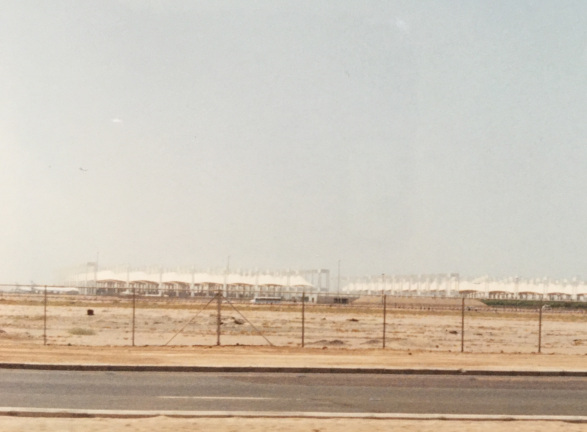
Don't Ask. Don't Tell
Another aspect of life in Saudi Arabia was a sort of "don't ask, don't tell" approach to many aspects
of daily life there. Here are a few final notes about that.
Alcohol
Although there was a nation wide proscription against the use of alcohol, most
Saudis, particularly those educated abroad, were aware that westerners in the country did have access to
alcohol, but chose not to do anything about that. In certain neighborhoods of Riyadh, there was a large
presence of foreign nationals from the U.S. and Europe. Generally housed in "compounds" of perhaps ten
to thirty homes, these foreigners would occasionally have parties or other social events at which
alcohol was served. It was rare for there to be any complaint from neighbors or action from police as
long as the activities occurred behind the closed doors of the compound wall. On one occasion during our
stay there, personnal from the British hospital in Riyadh staged a large party where alcohol was
served. The partiers left the gates open and after some drinking began to invite passers-by and Saudi
neighbors into the party. Neighbors called the police, who came by and warned the party to
close the gates and stop inviting Saudis to the party, but the party continued and persited, and
after a few more hours, the police reluctantly arrested the people at the party. Although possession
or use of alcohol within the Kingdom generally resulted in severe penalties (public flogging, prison)
in this case, the foreign nationals were simply quietly deported. This was often the case with
personnel of countries such as the U.S., Britain, Canada, or other European nations. People from
other countries, such as Pakistan, Bangladesh, Thailand, or the Phillipines were not usually so
lightly punished, especially if Muslim.
The Brits at the hospital in Riyadh, by the way, had worked up a recipe for home-made wine
that produced pretty consistent, drinkable results. The recipe used locally available items,
such as the bottled grape juice, sugar, and yeast, available at the supermarket, and produced
a product in a few weeks. If bottled and aged another few, it lost the raw yeasty flavor and
made a fair table wine. It was common to see western nationals checking out at the market
with a cart containing a couple of cases of grape juice, large bags of sugar, and multiple
packets of yeast. No one thought anybody was unaware of what was going on. It was the
prevaling attitude: What goes on behind closed doors is nobody's business.
The Saudi Arabian International School in Riyadh (SAIS-R)
Saudi Arabia had a public school system modeled on the U.S. system and education was free
all the way through graduate level university training for all Saudi citizens. Although
much of the system was segregated by gender, women made up a large proportion of the
student population all the way through graduate school. The Kingdom was one of the
few countries where female graduates from medical school outnumbered the male graduates.
But the Kingdom forbade the establishment of schools by foreign countries. Despite this
proscription, there were multiple schools established by other nations, mostly in
the urban areas. There was, for example, SAIS-R, The "Saudi Arabian International
School - Riyadh", which was a huge structure on the outskirts of Riyadh offering
K - 12 education for over one thousand students staffed by educators from the U.S. and
other nations. Today, it is known as AISR, the "American International School in Riyadh"
Instuction was entirely in English. Although technically illegal, the school had
a significant number of Saudi students and during our stay there, was formally
visited by Sultan bin Salman al Saud, who had been a fighter pilot with the
Saudi Air Force and flew on the Space Shuttle in 1985. Known as 'The Space Prince",
Sultan, the son of the current King of Saudi Arabia, Salman, then the
governor of Riyadh Province, spoke to the student body at an assembly program
and distributed photographs and autographs to attendees. It would be hard to
believe that the "authorities" were not aware of the existence of the school.
While we lived there, Ellen worked at the SAIS-R as librarian. She was in the
country on a dependent visa, attached to my work visa. Her visa did not permit
her to work while in the Kingdom. But she worked at the school full time
with the knowledge of our sponsor JECOR and was provided transportation to and
from work. All our three children went to school there. It was likely the
best school they ever attended. The international make up of the student body
was an education in itself and a constant stimulation toward excellence.
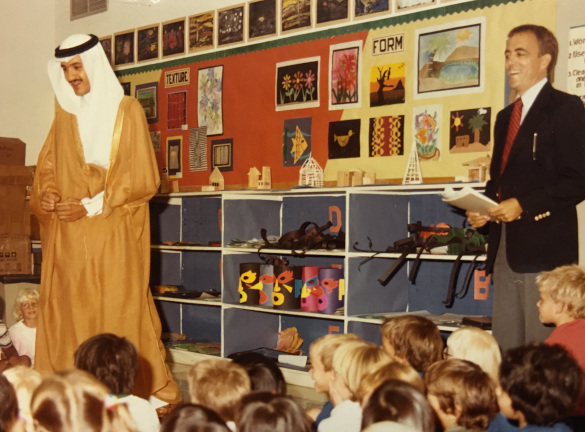
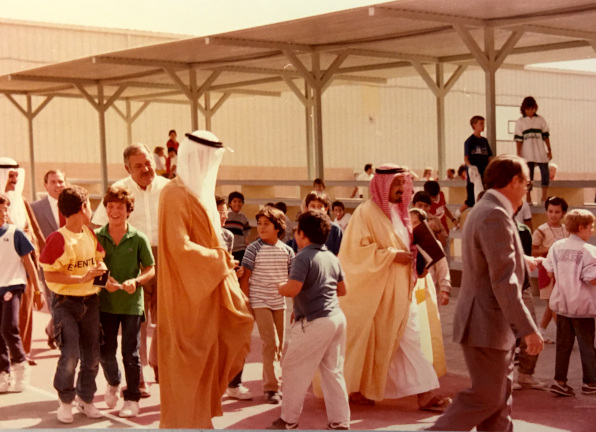

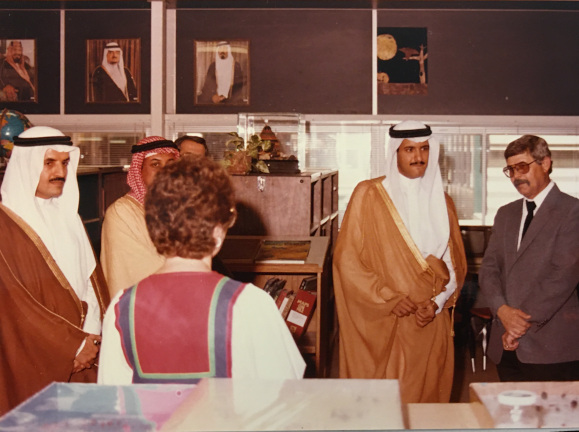
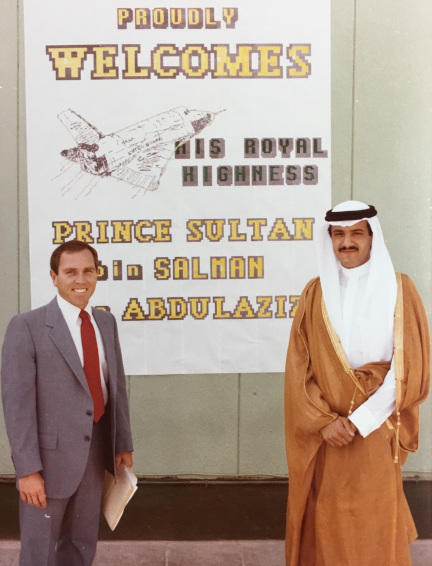
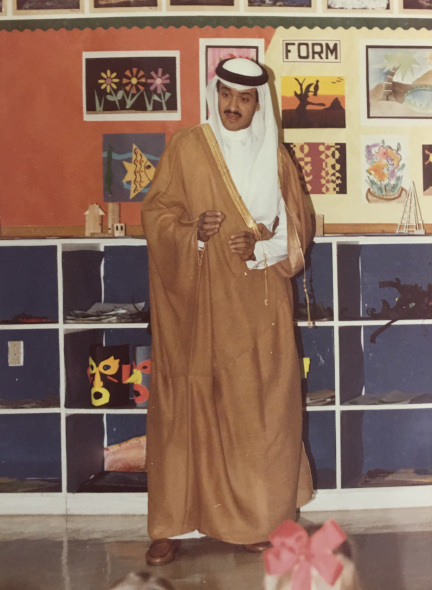
And a final picture of the two of us in Saudi dress,
headed for the market, incognito.